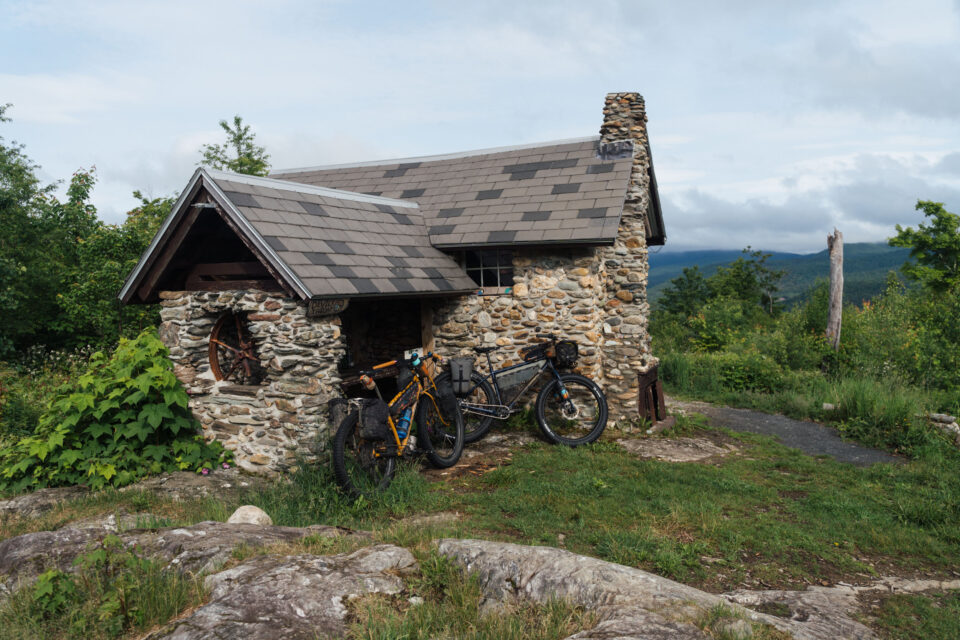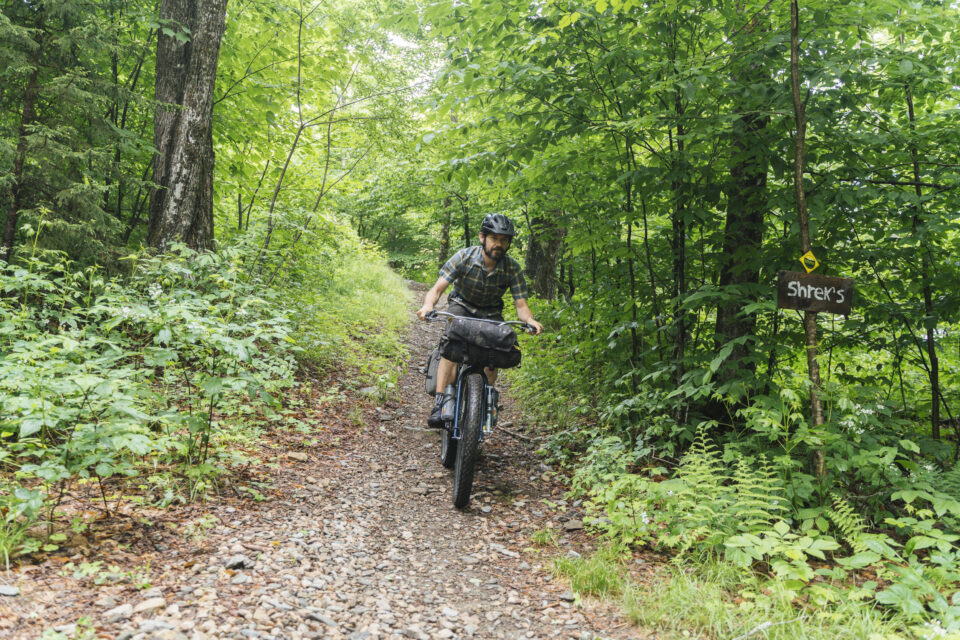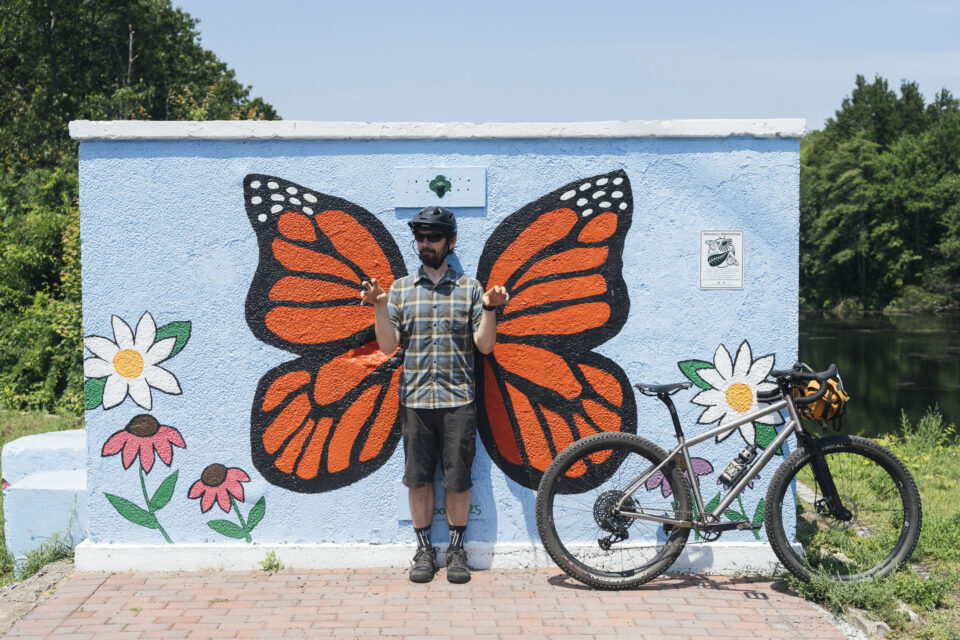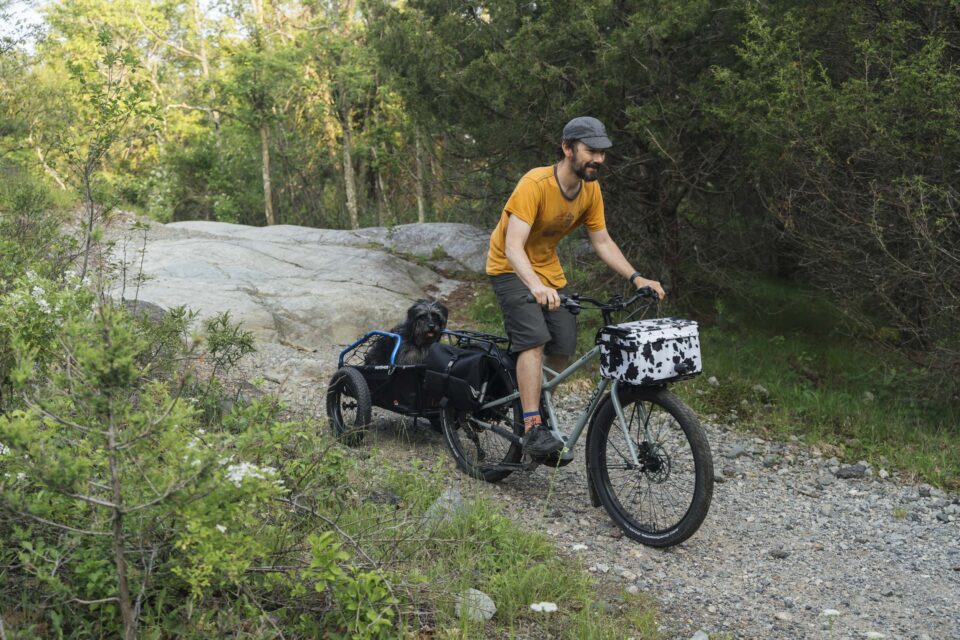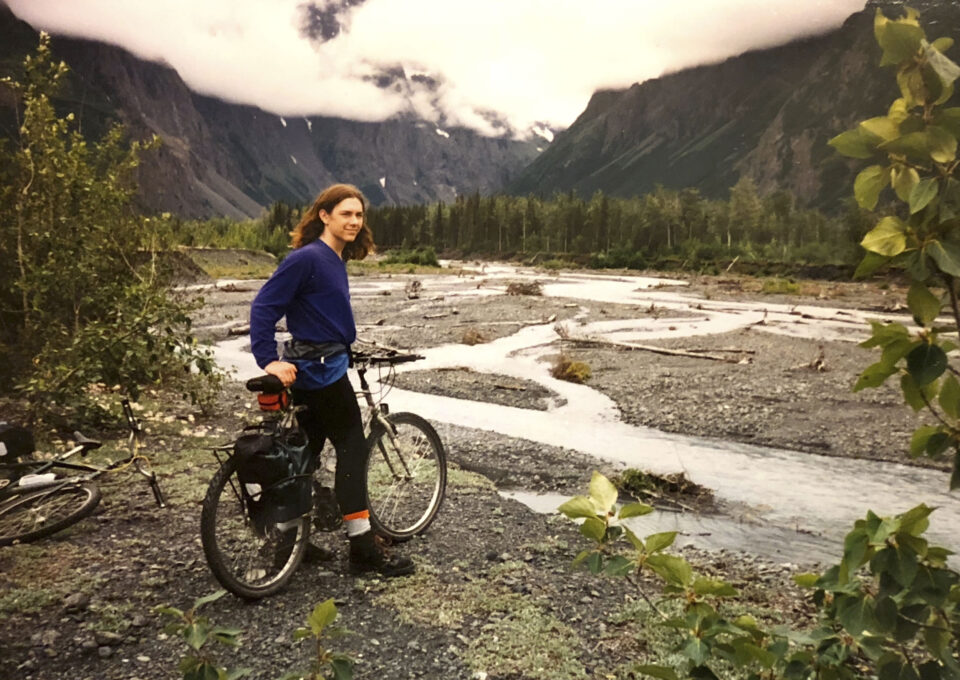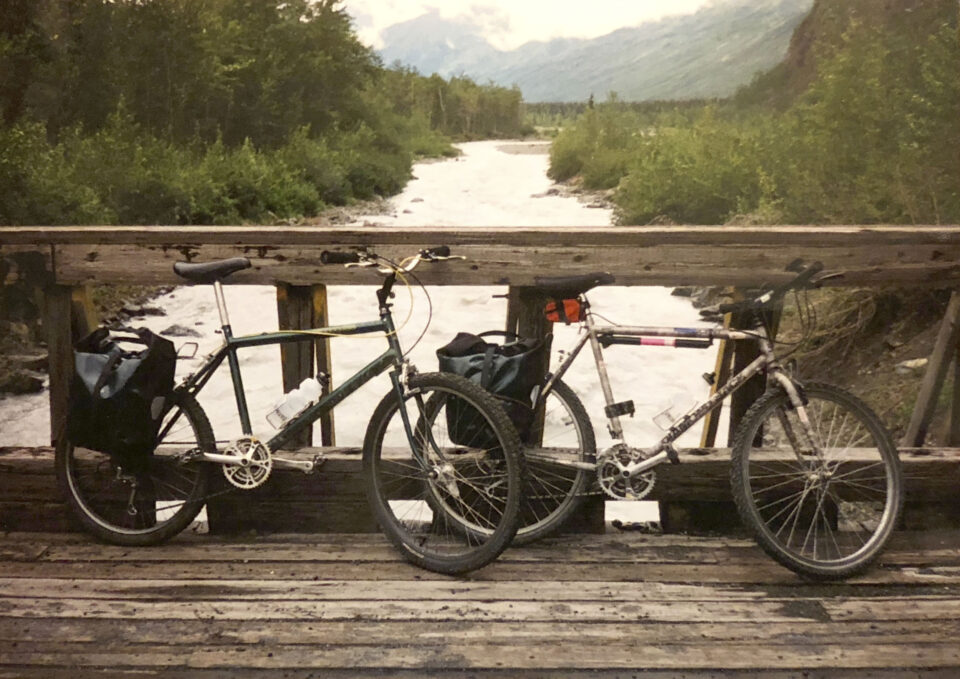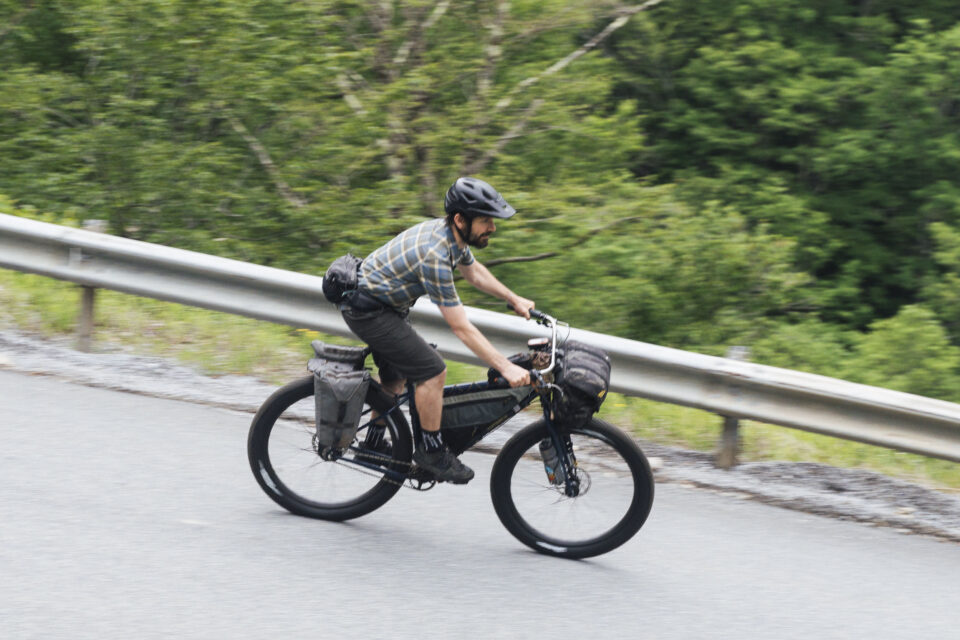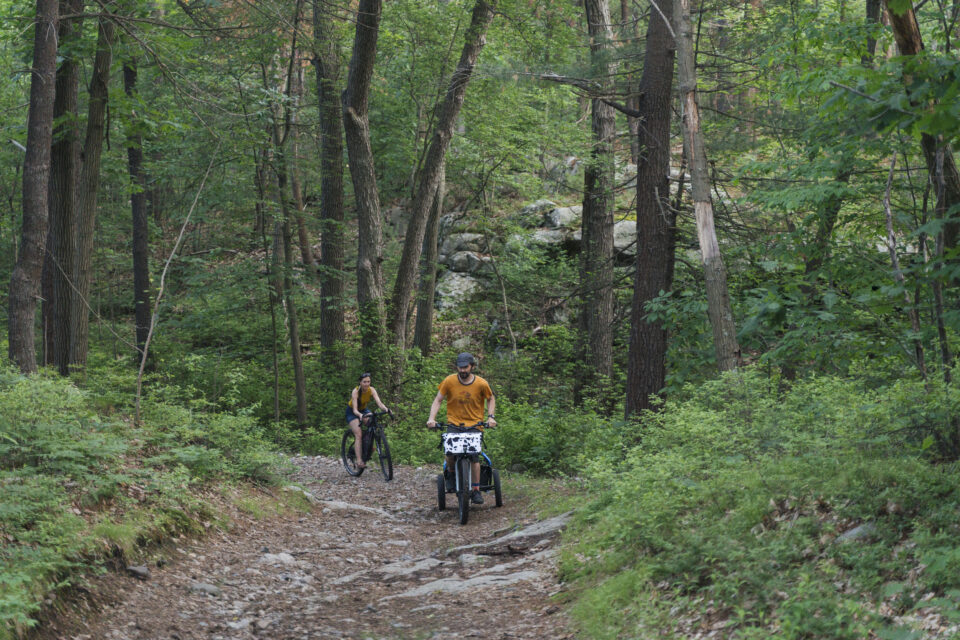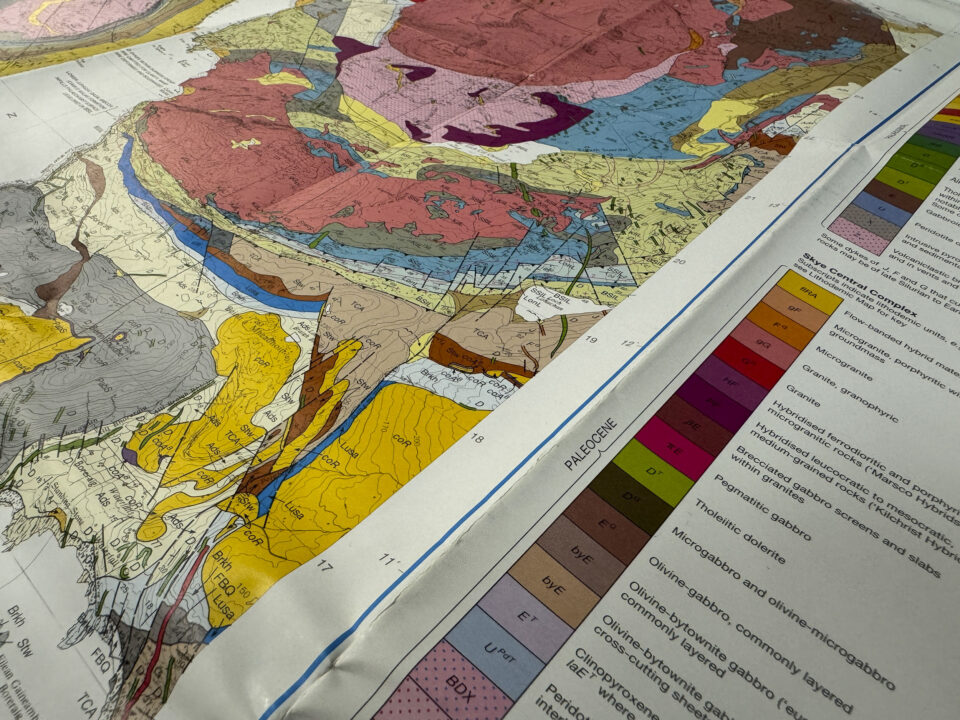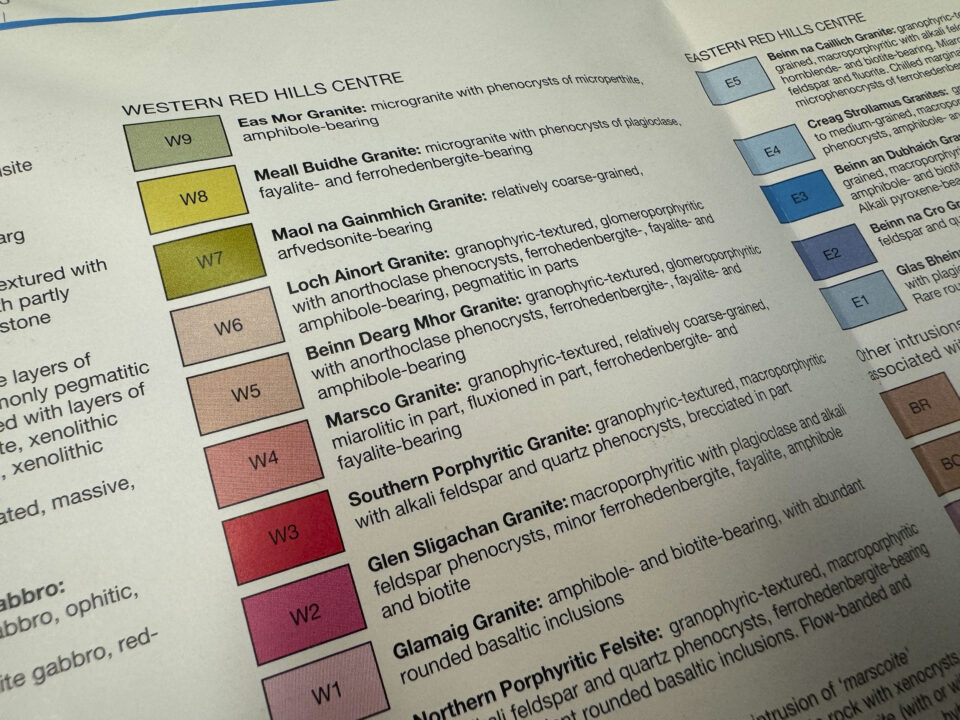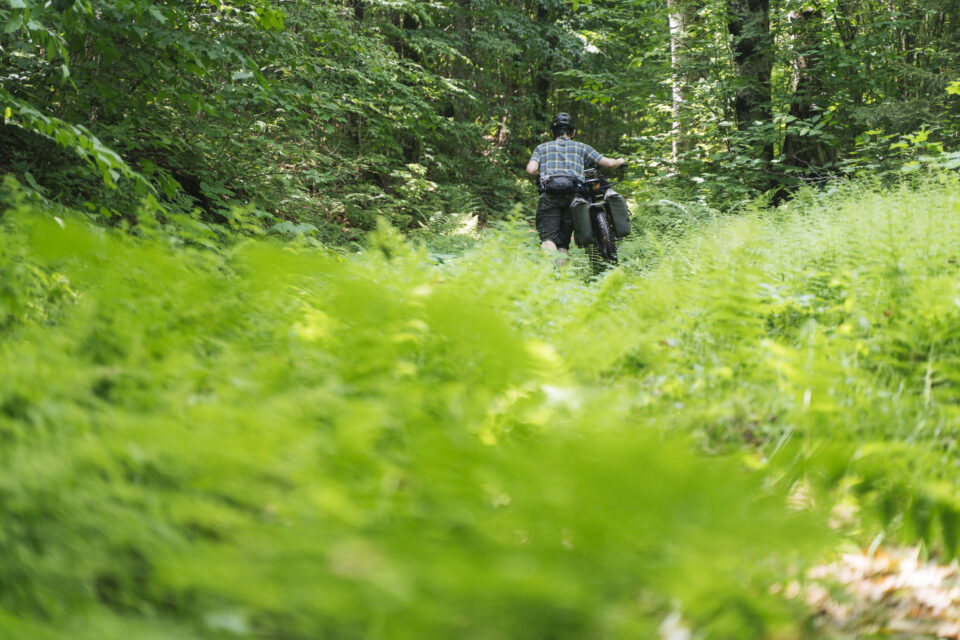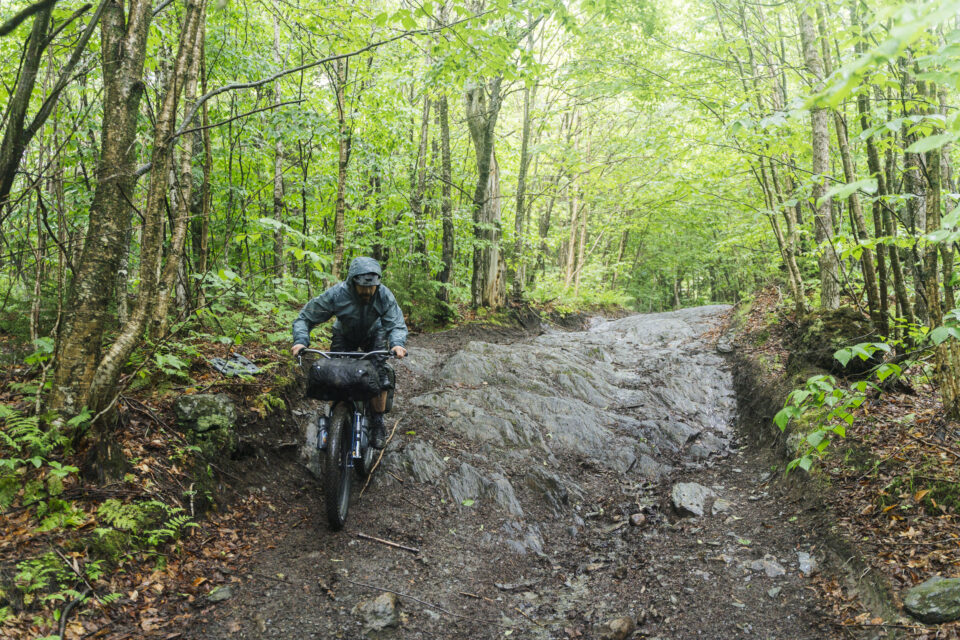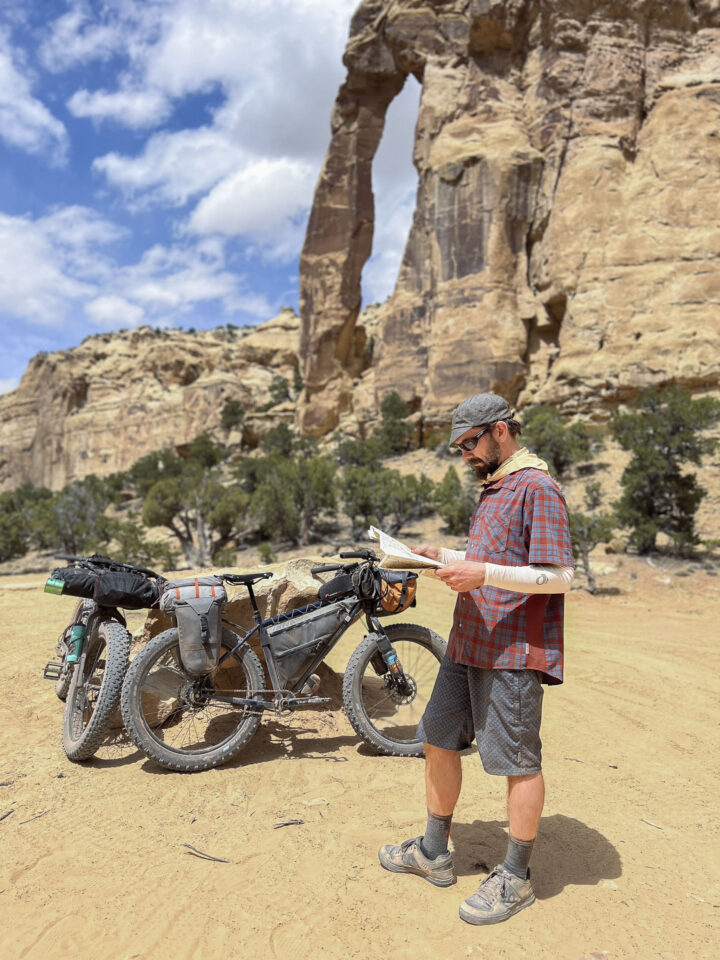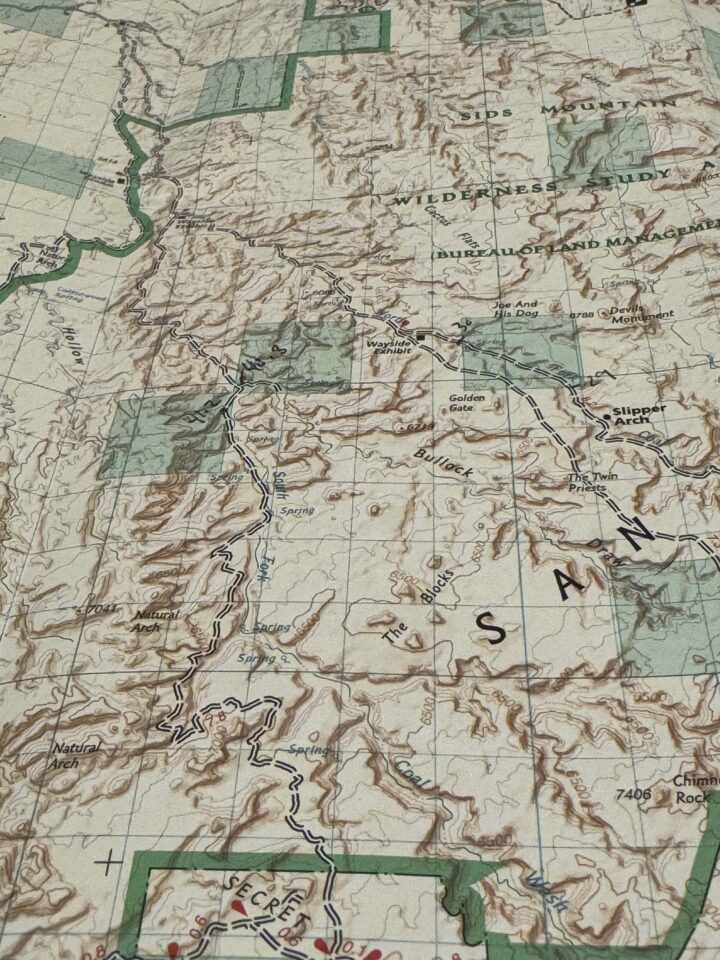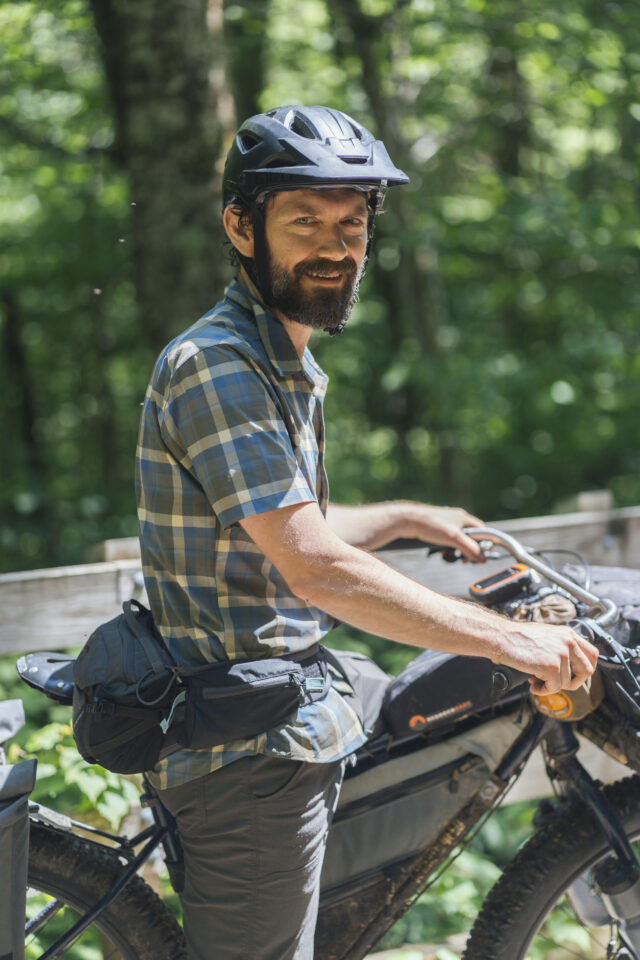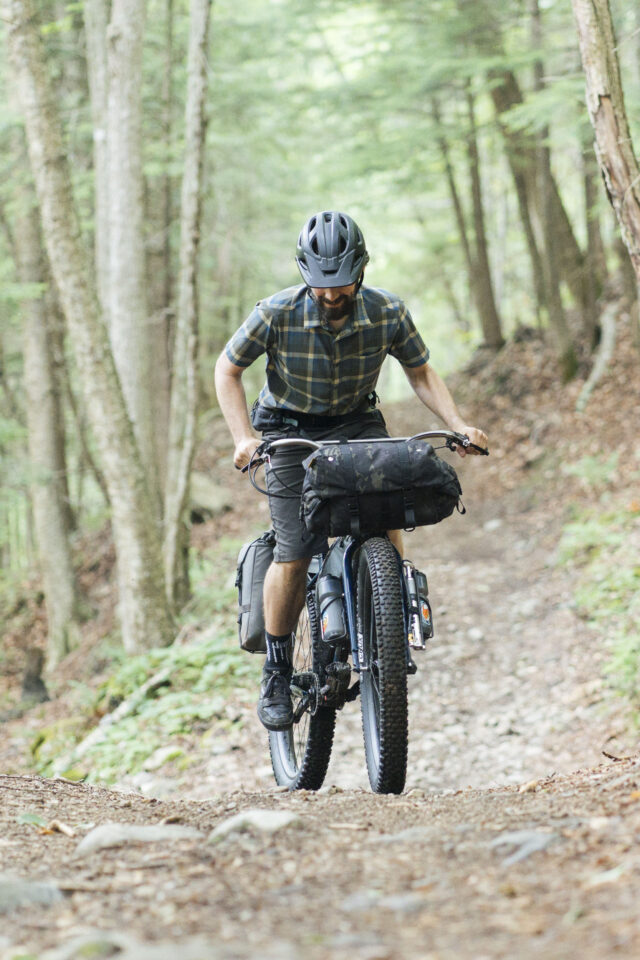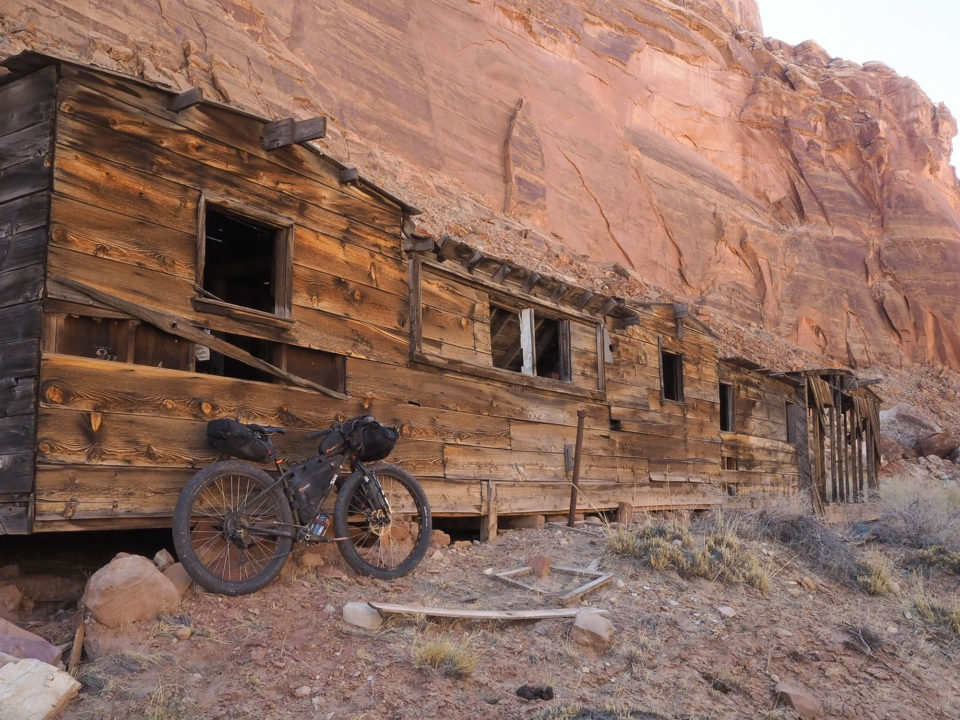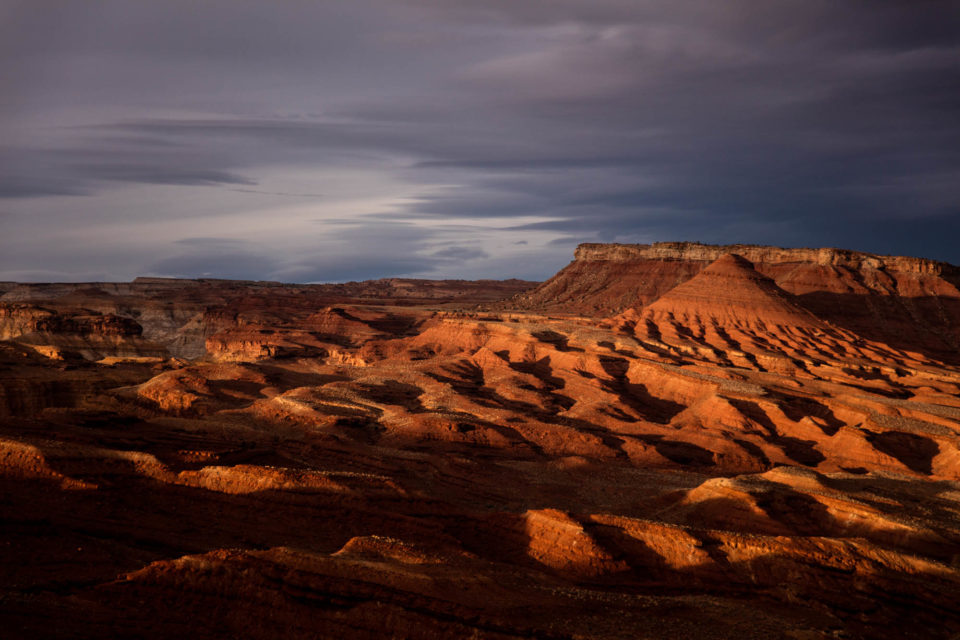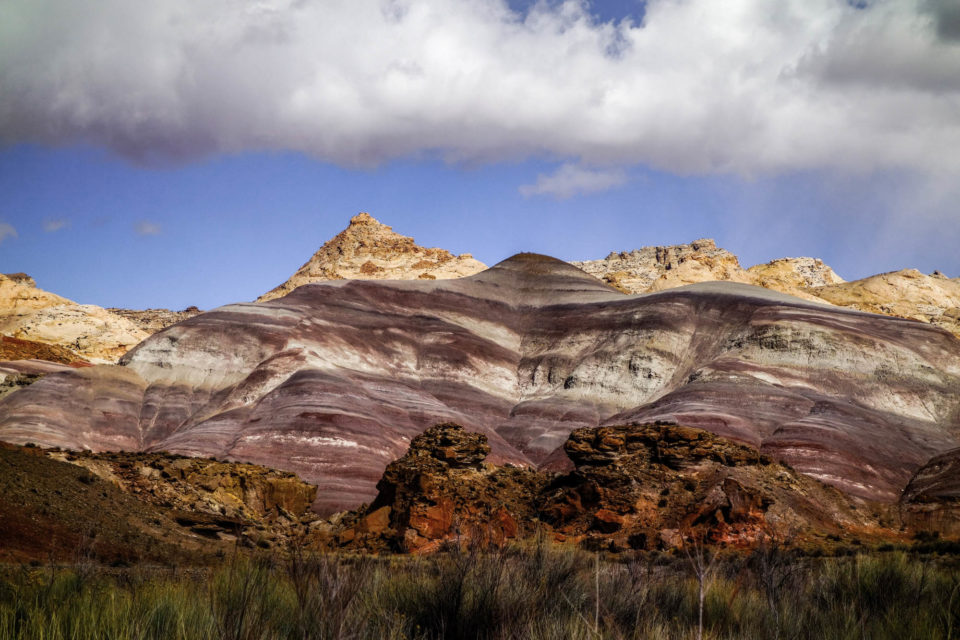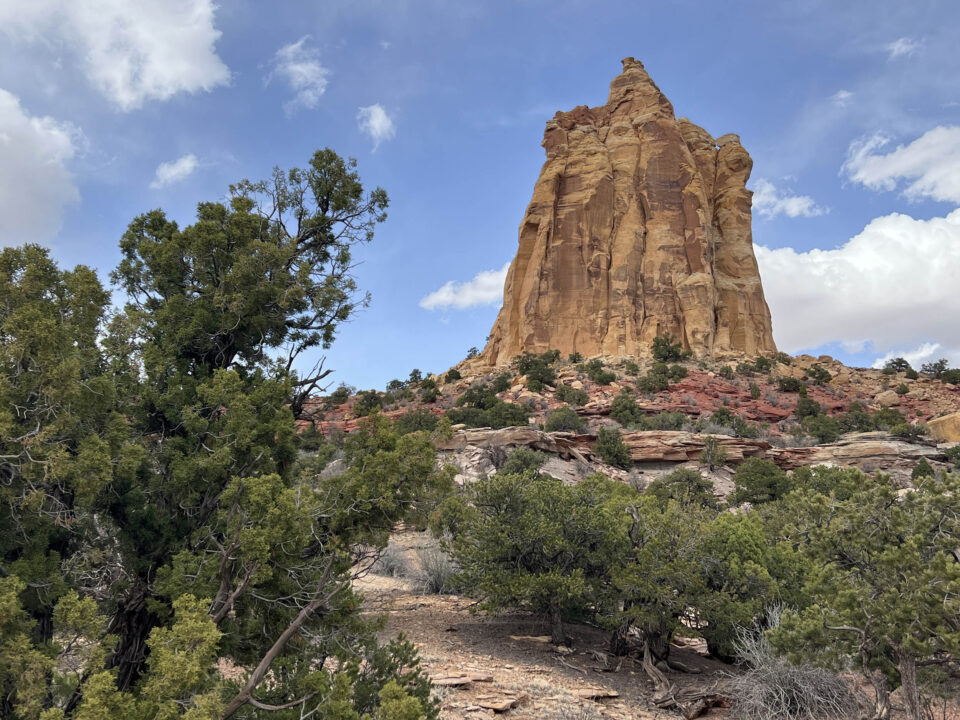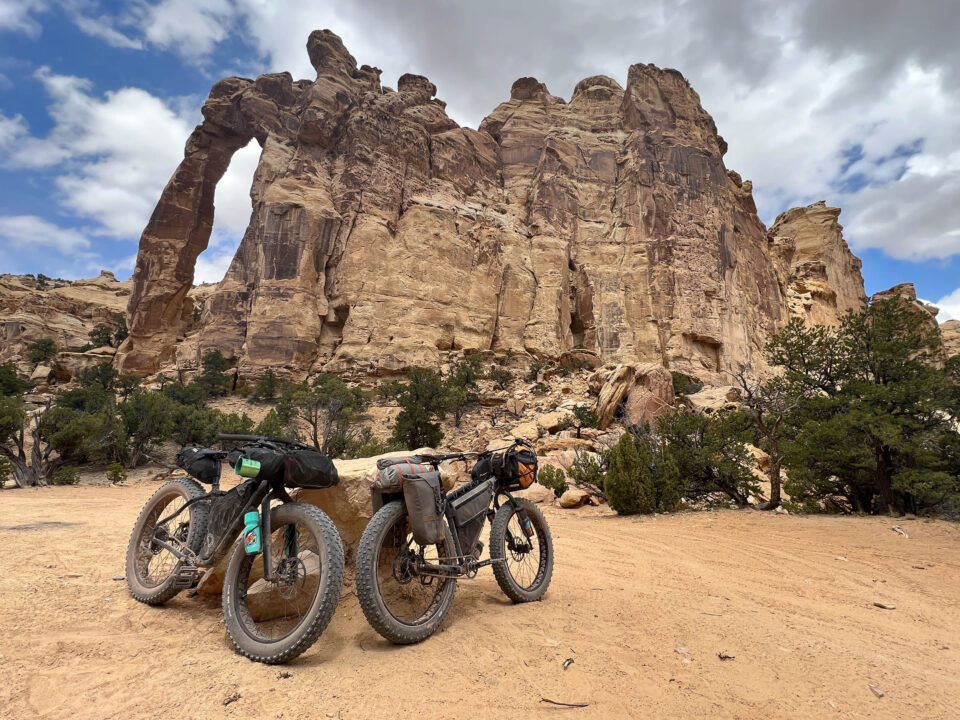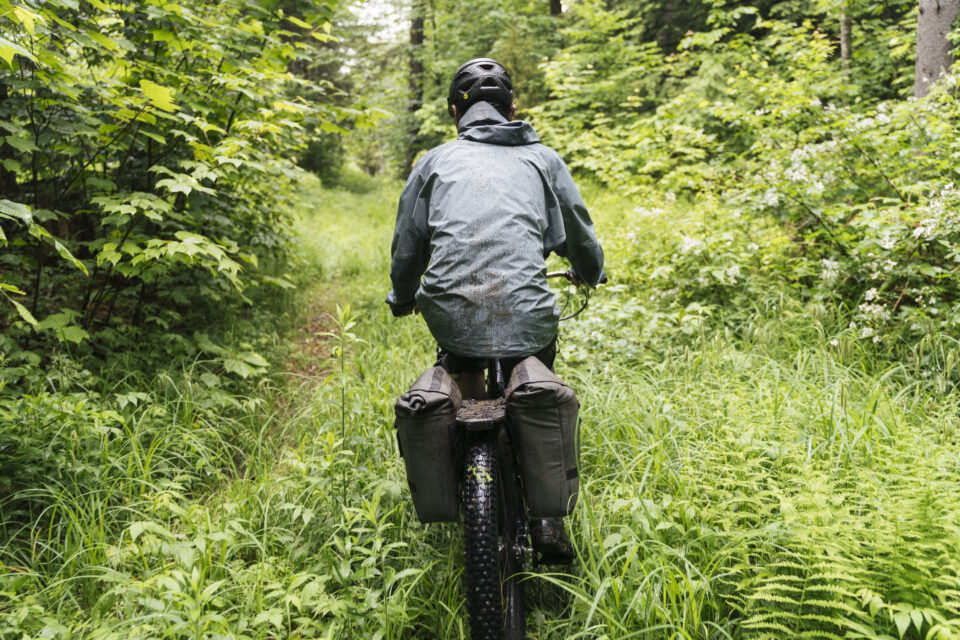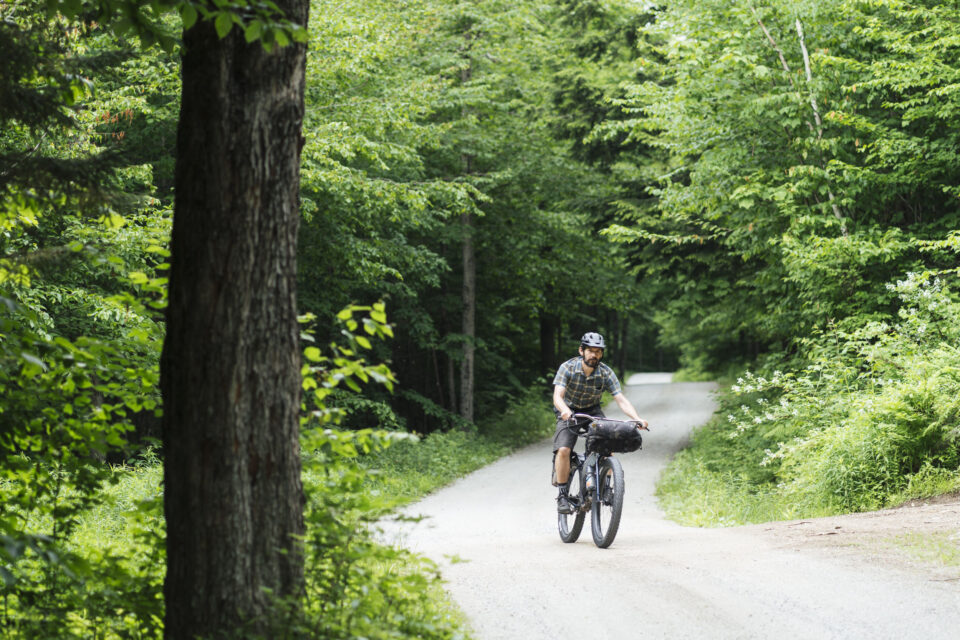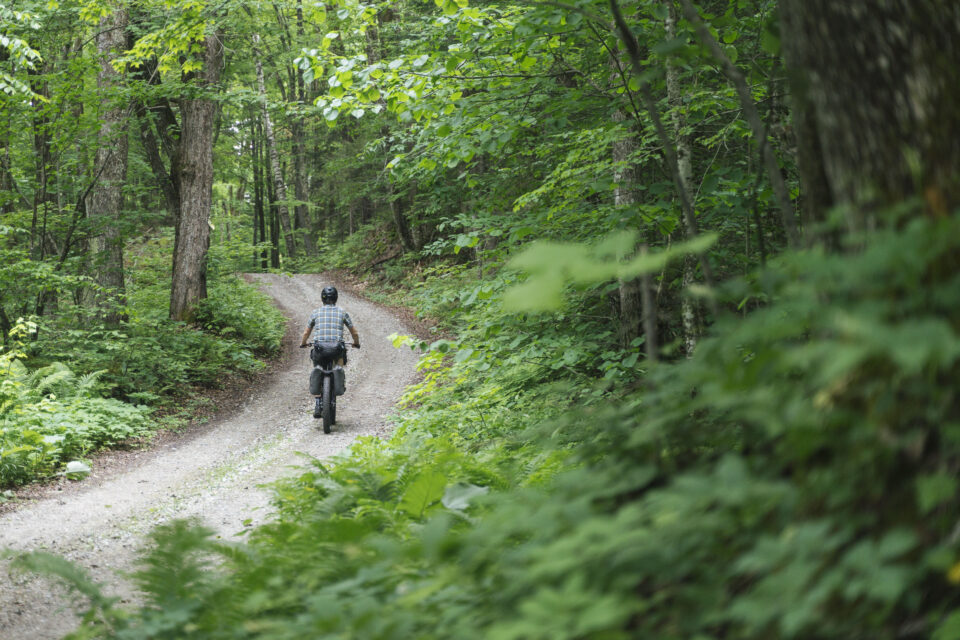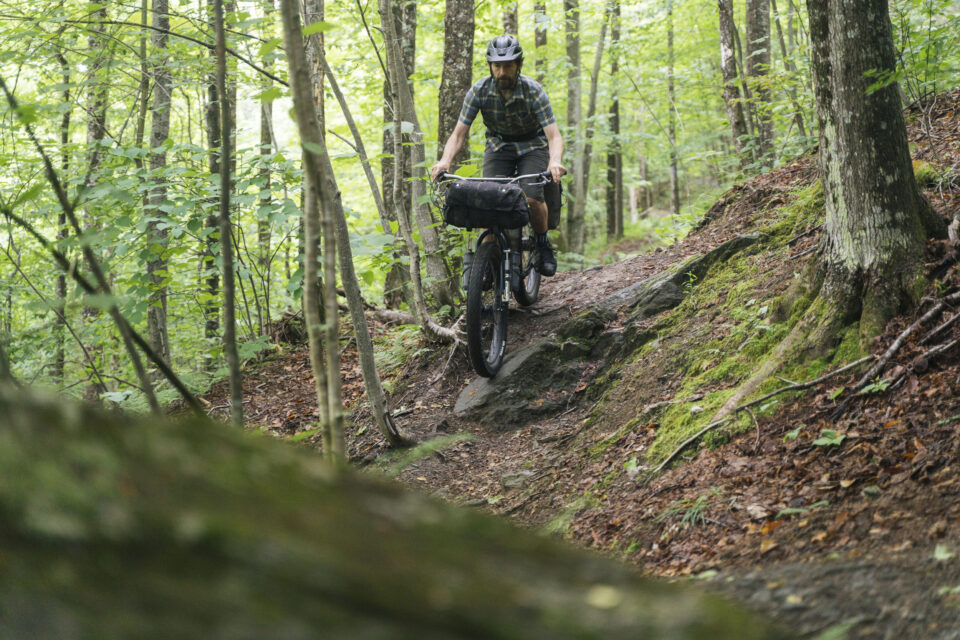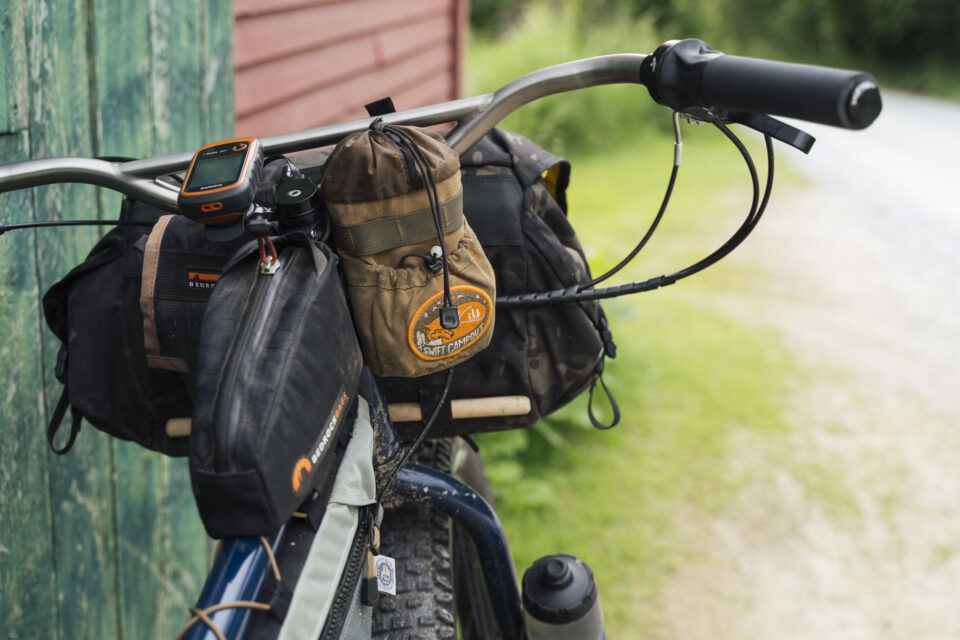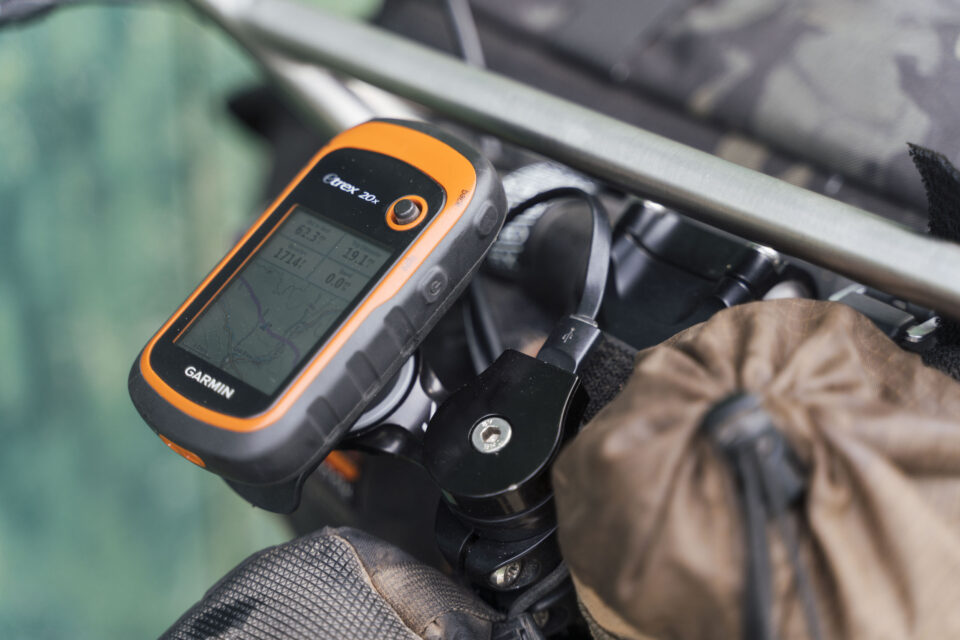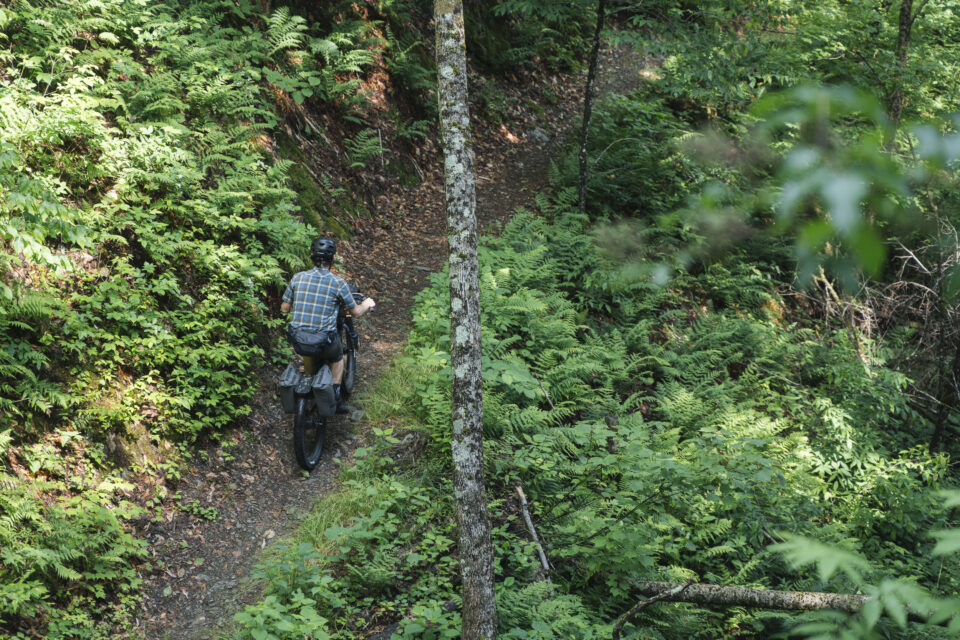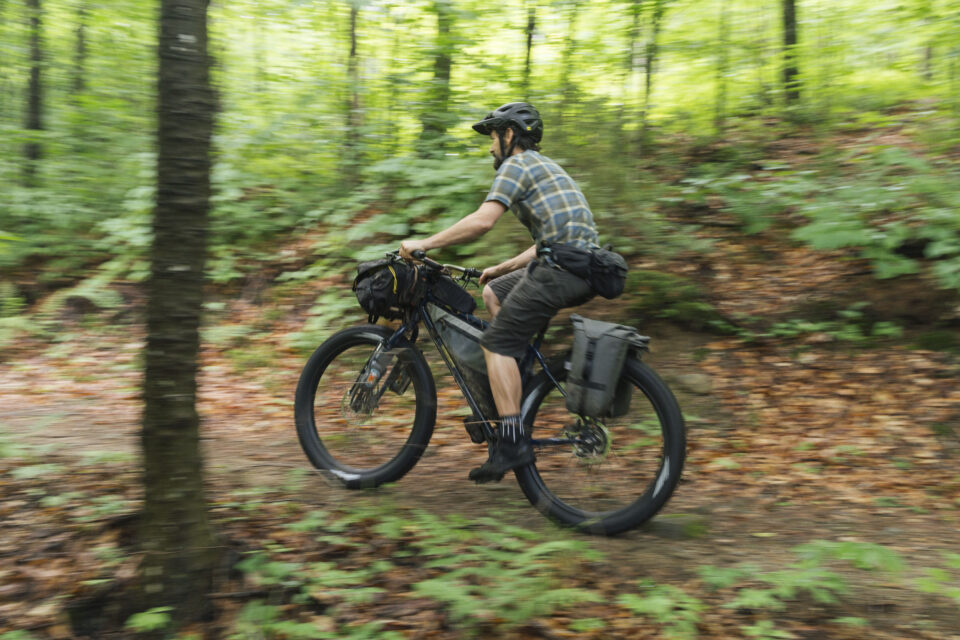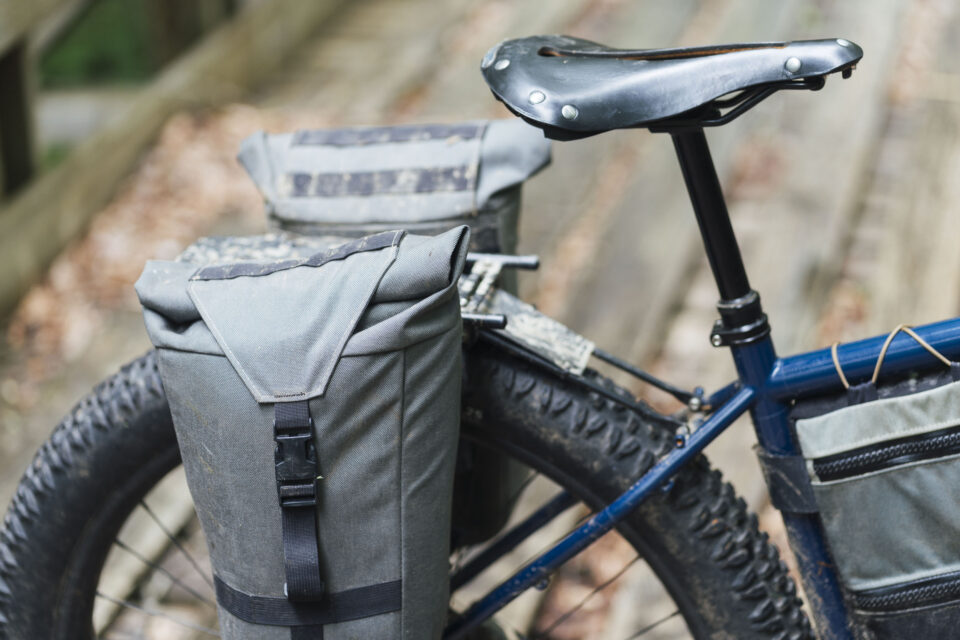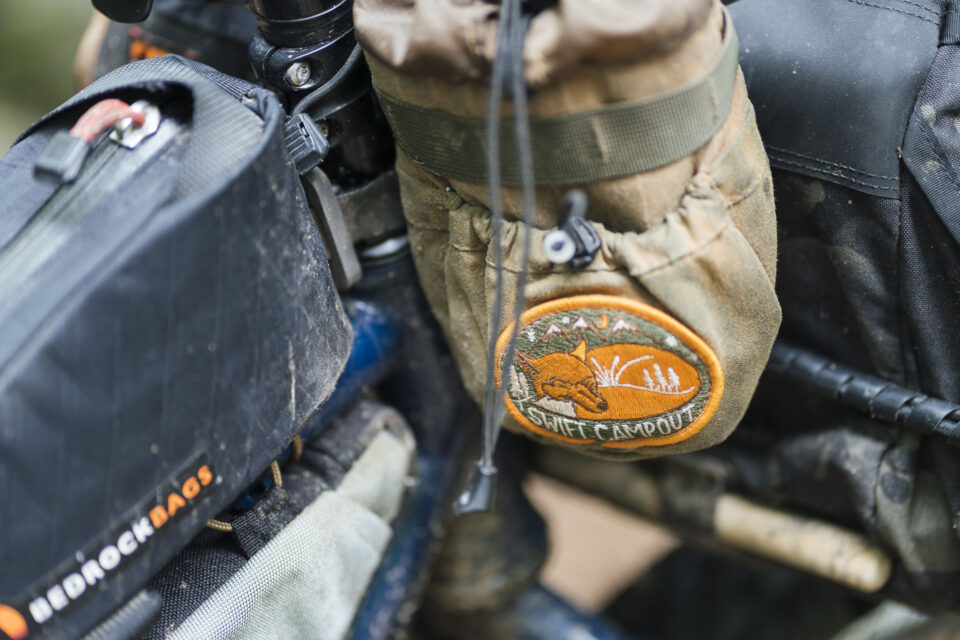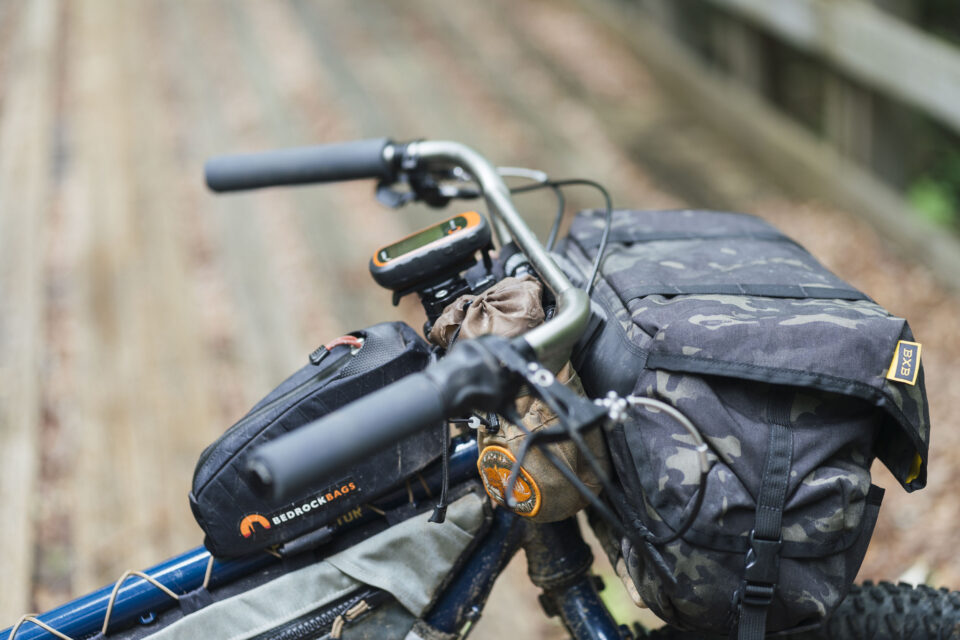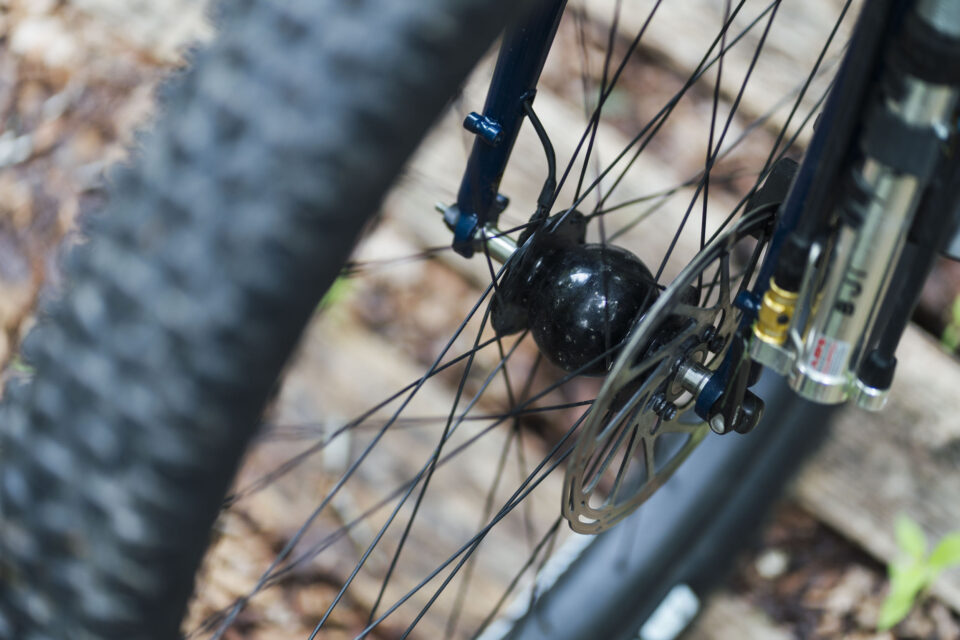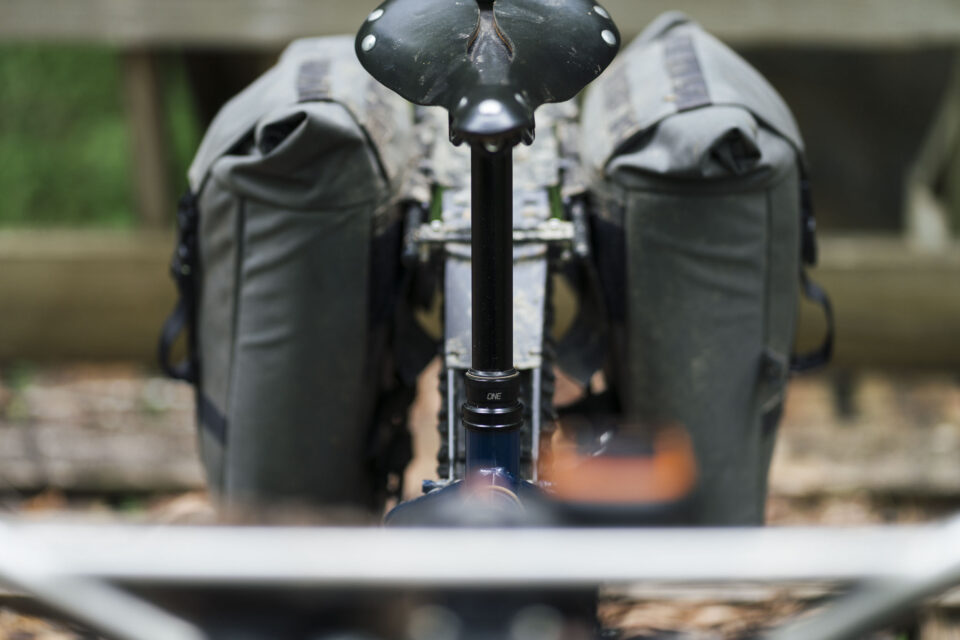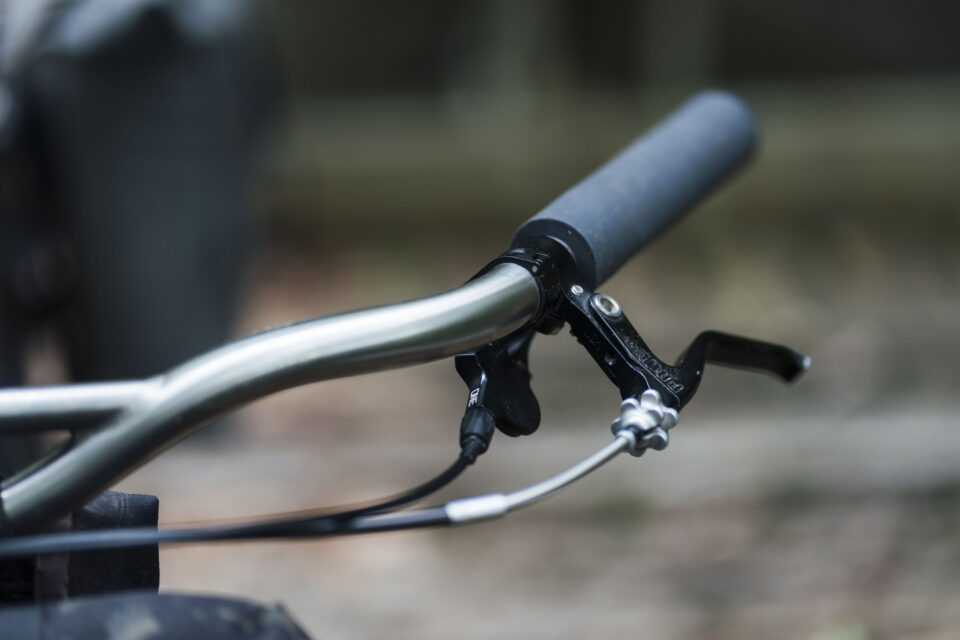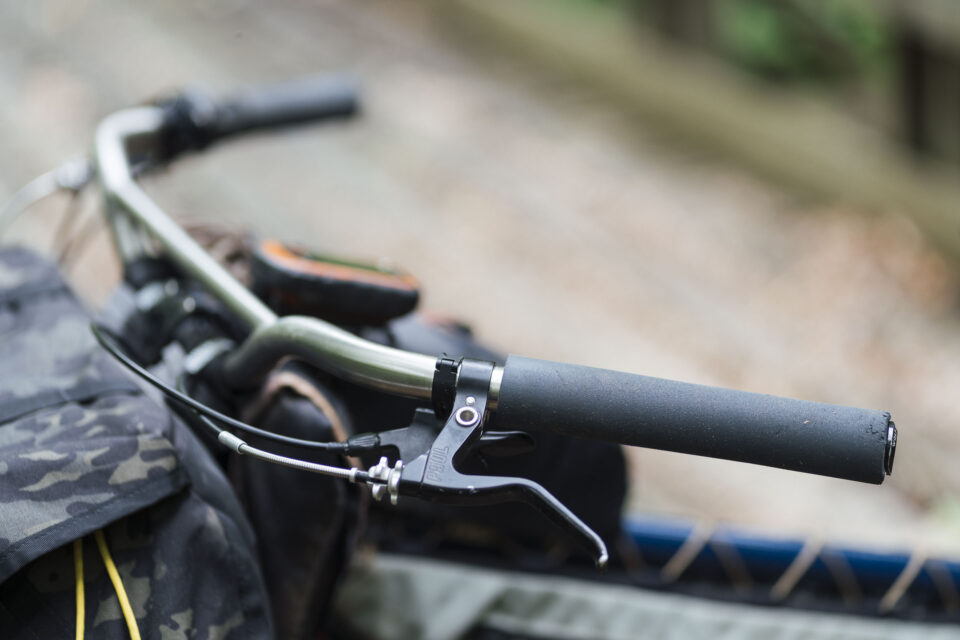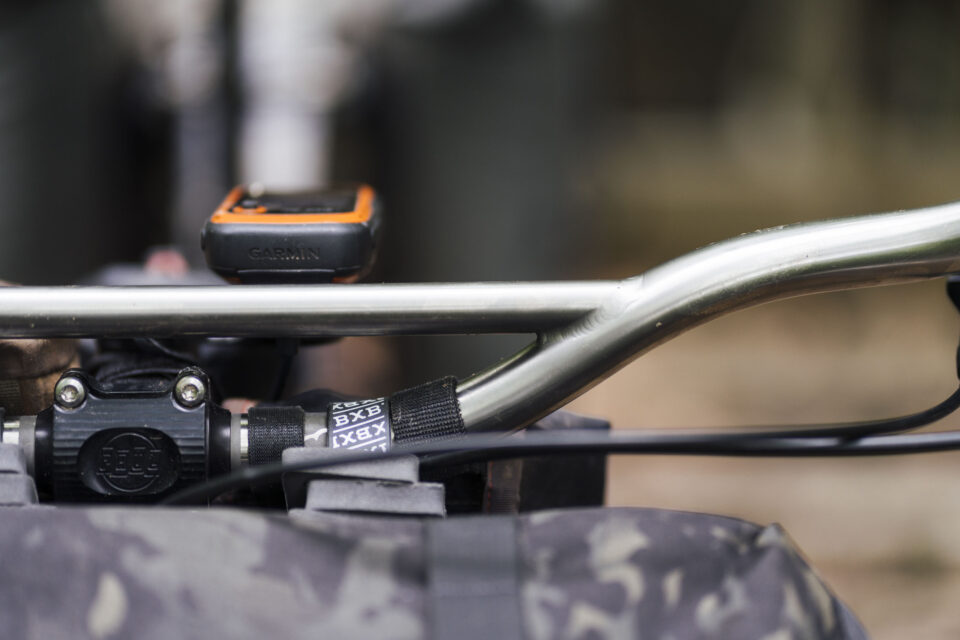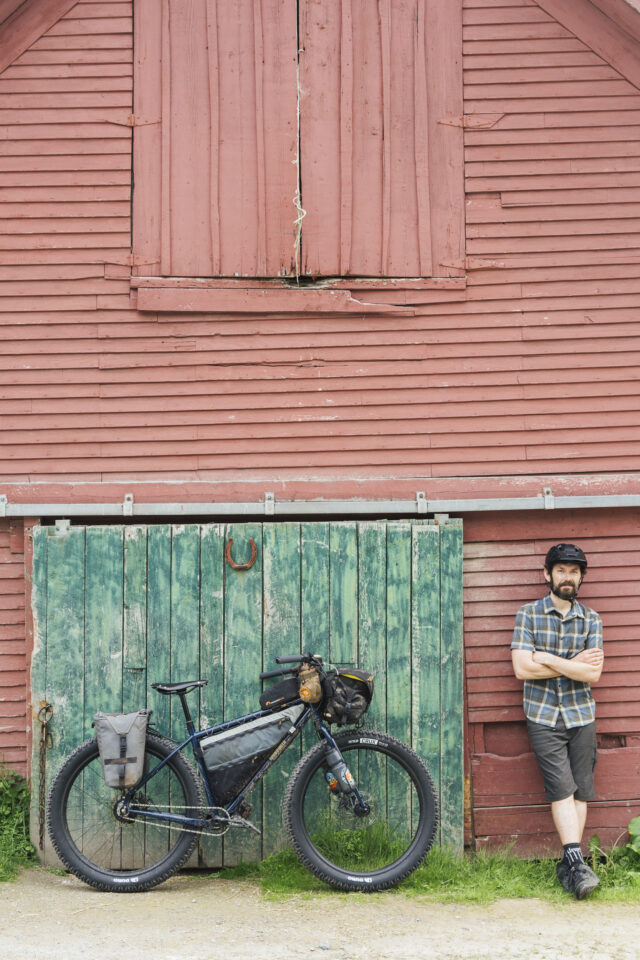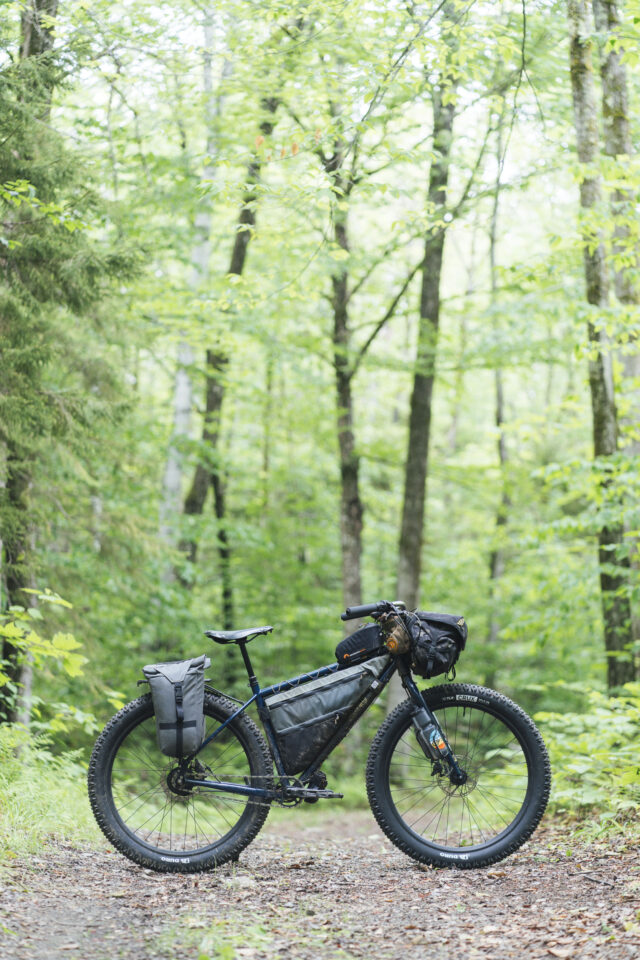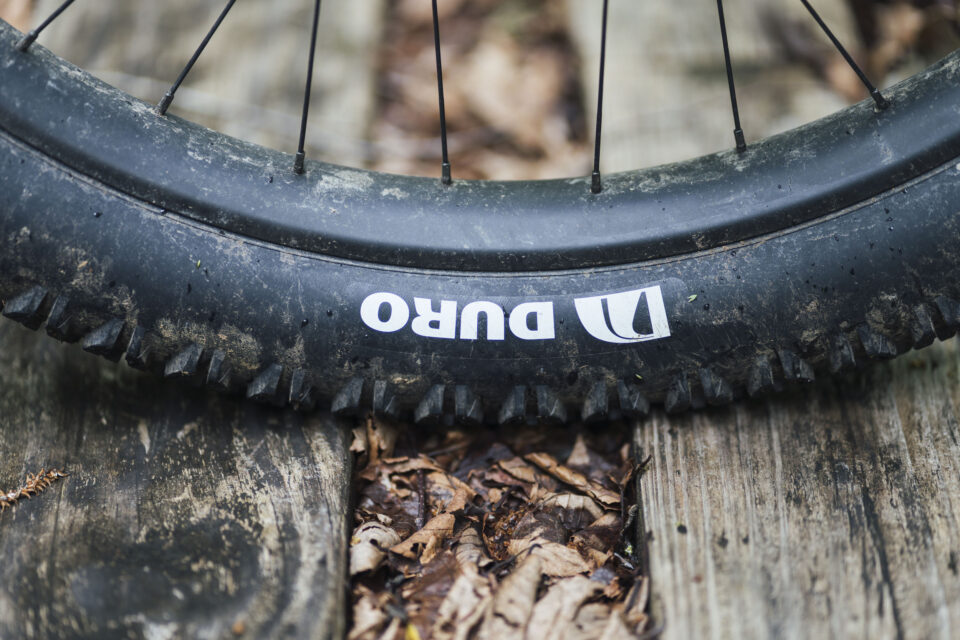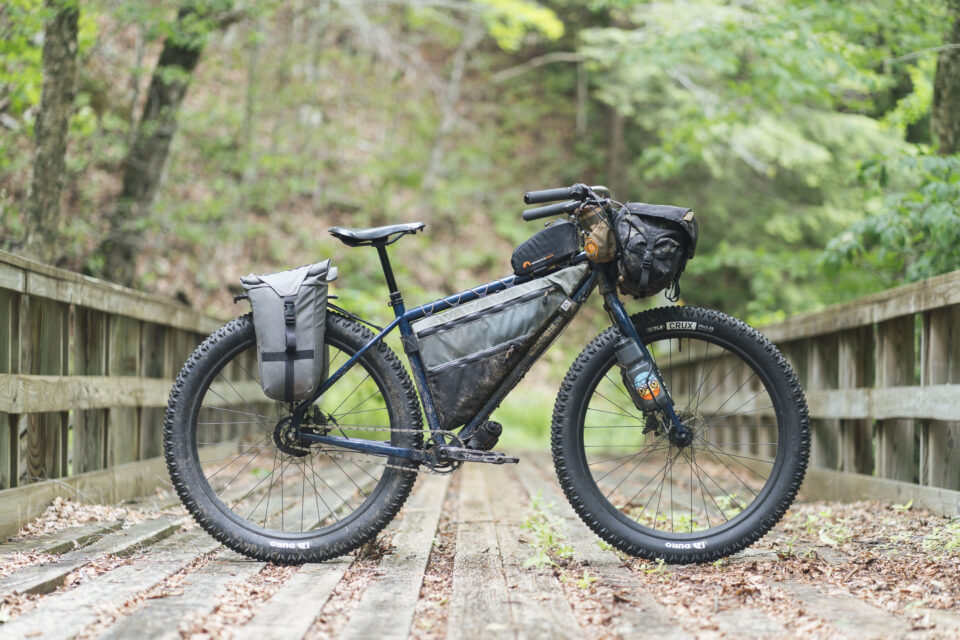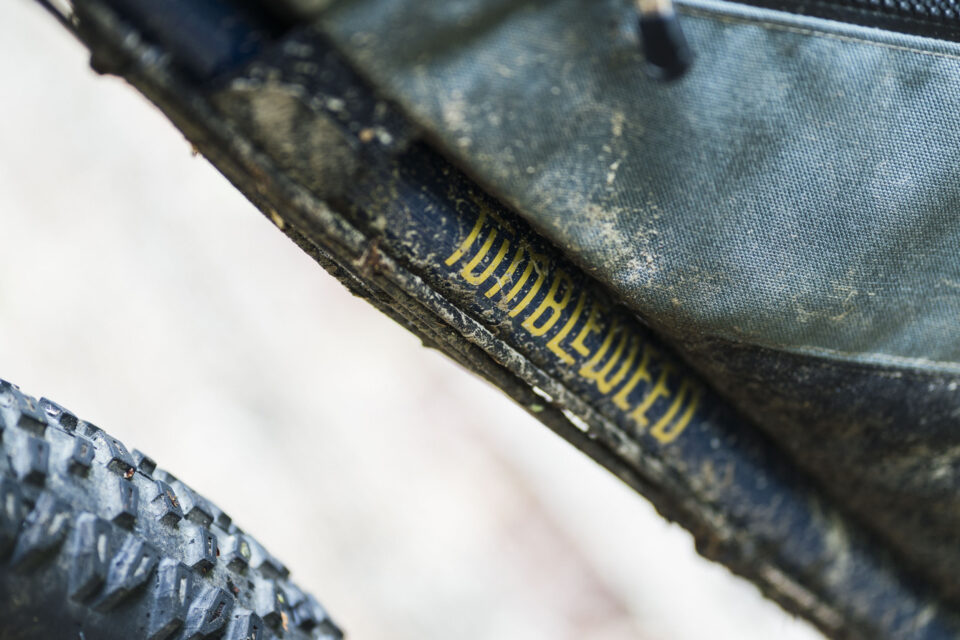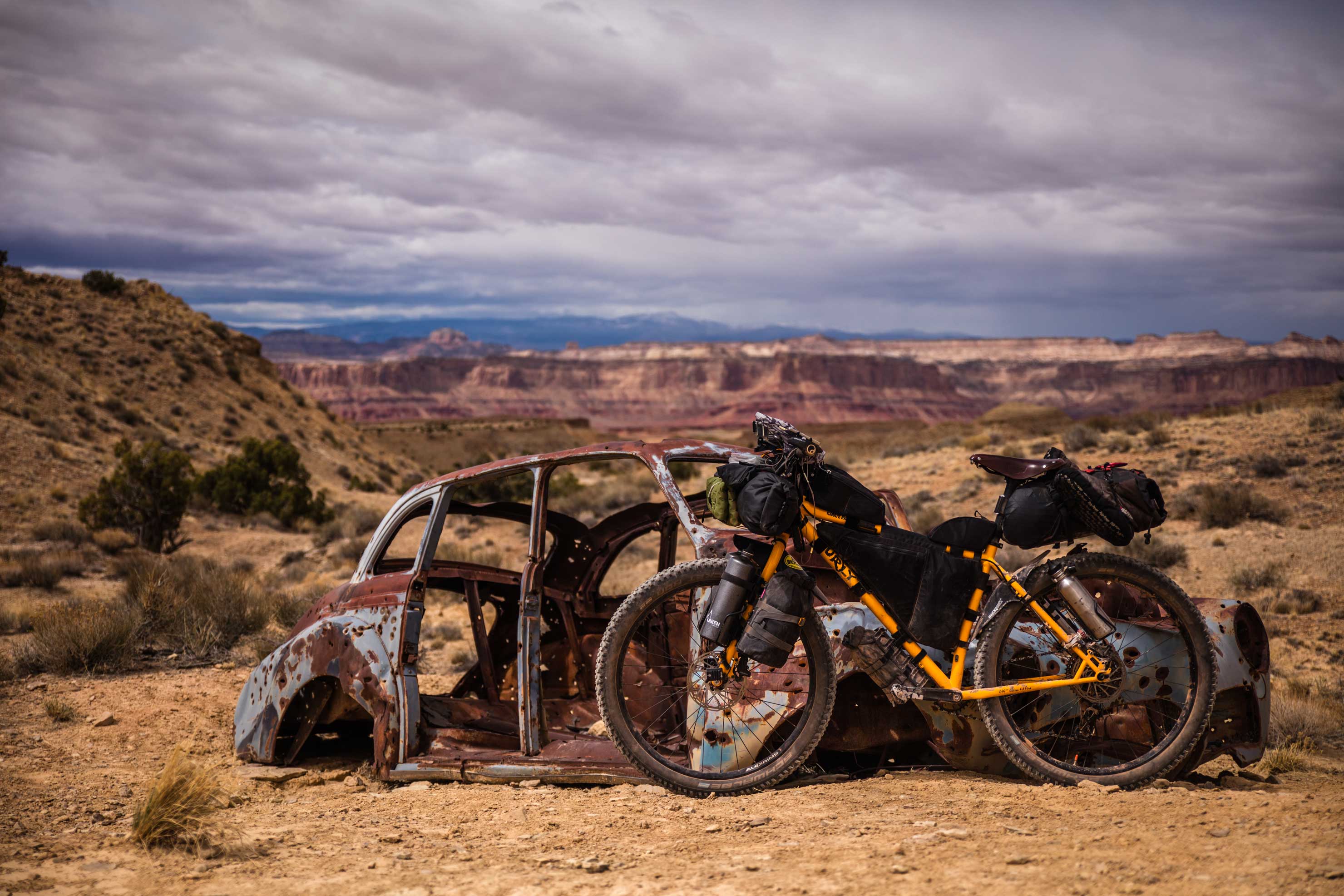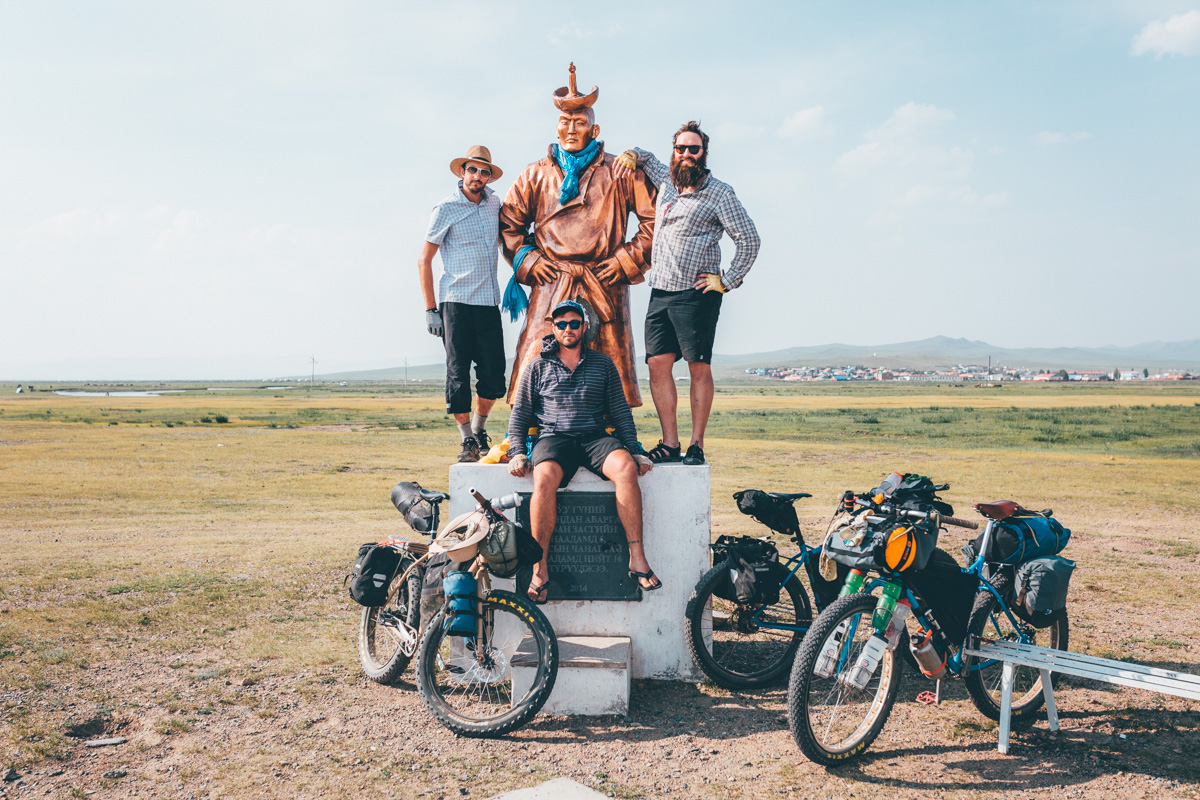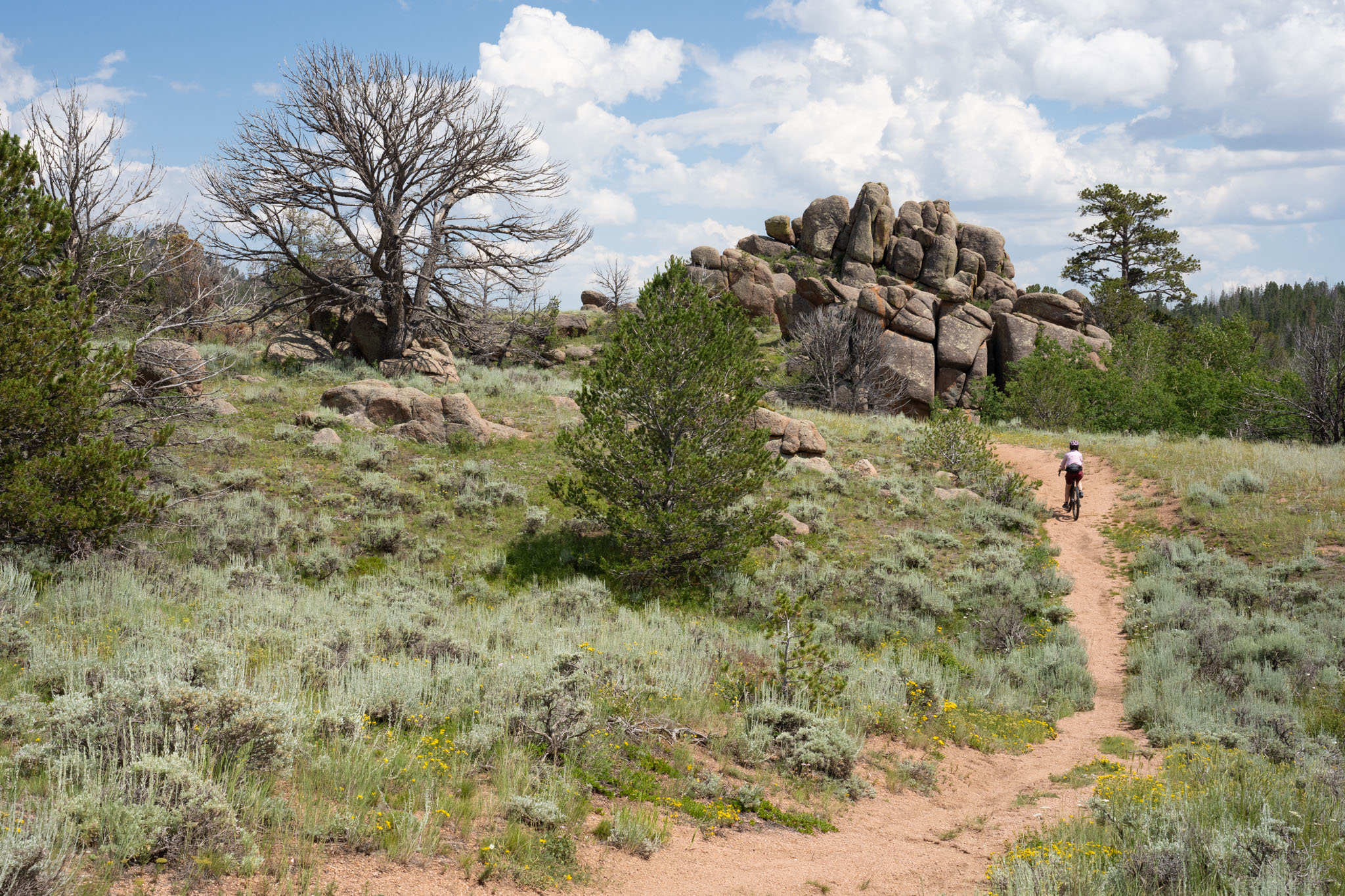Geologist Seth and his Tumbleweed Prospector
Share This
In our latest Rider and Rig feature, we catch up with geologist, educator, and route builder Seth Kruckenberg, creator of several fabulous desert rides published on this site. As well as dissecting his all-terrain, Rohloff-powered Tumbleweed Prospector—a stunning build that includes an unusual but elegant set of handlebars—Seth shares insightful tips on understanding geological terrain and using topography for route creation so you can plan spectacular trips of your own. Find it all here…
Last year, I had the good fortune of meeting up with Seth Kruckenberg. If it’s a name that’s familiar to you, it’s likely because Seth has penned a number of geographically spectacular routes on this site, including the recently published Vedauwoo Rendezvous, showcasing Southeastern Wyoming’s granite slabs and towering spires, and the Secret Mesa Loop in Central Utah. The latter is wonderful desert ride that highlights the tectonic uplifts and human history of the striking San Rafael Swell and was amongst our favourite overnighters for 2023.
As a geologist and an educator, Seth approaches route building with a distinct mindset, which is something he’ll be sharing with us in this post via a series of hints, tips, and resources for helping readers to create their own geologically intriguing routes.

Not that his travels are solely on fat bikes through the American Southwest. Boston-based Seth helped me plan my own trip to Vermont last spring, even putting together a three-day loop that included a night in Shrek Hut, a characterful stone dwelling atop a hill in the Green Mountains, complete with a pot belly stove, wooden bunk beds, and colourful enamel mugs. It’s another route that he’ll be sharing soon, and the source of the photos used in this post.
Seth is also the quintessential bicycle enthusiast, with an impressive home workshop and an enviable collection of machines, including a titanium Tumbleweed Stargazer built to cover miles at speed and an electric-assist Surly Skid Loader for commuting to work in the city and hauling his two dogs. But it’s his first Tumbleweed, a Rohloff-powered Prospector set up with 29+ tyres, that we’re focusing on for this post. It’s the bike he brought along for our Shrek Loop and the one he’s ridden on many of his trips, thanks to its ability to shape shift with different wheel and tyre configurations.
From our conversations, it’s clear that the outdoors have played a big role in your life, whether for recreation or work. Can you tell us where this is rooted and how you interweave the two?
I grew up in Wyoming, the least populated state in the US, so I guess it’s just by geography that I was preconditioned from an early age to favor regions of the world where people were vastly outnumbered by acreage. That, and the wild, open landscapes that characterize much of the Western US.
Both of my parents come from rural farming communities in North Dakota, and my father is an avid hunter and outdoorsman who worked for the Wyoming Game and Fish Department for most of his life. As kids, our family outings frequently involved trips to the mountains, searching for wildlife on car rides, or tagging along while my dad had a summer meeting in another western city or state. As a Gen-Xer who also grew up in the 1980s and ’90s, before screens and the internet consumed so much of our collective attention, my entire childhood was spent riding around on BMX bikes with friends, building forts, playing in the dirt, and constantly being outside unsupervised. No one wanted to be indoors, and we waited until sunset or our parents beaconed us home for dinner with a loud whistle from afar.
That upbringing is undoubtedly the foundation of my appreciation for the outdoors, and it ultimately fostered my curiosity for learning about the processes that shaped and changed the Earth through time, creating the various landscapes that defined so much of the backdrop of my childhood. It is perhaps not surprising, then, that as I got older, activities like mountain biking, rock climbing, and mountaineering were natural draws that led me to pursue geology as a profession. It dovetailed nicely with my interests and allowed me to have a career that kept me outdoors as a geologist and an educator.

And how did bikepacking become a part of this life equation?
If I wind the clock way back, I’d have to say that I first got into bikepacking thanks to my cousin who took me on my first overnight trip while I was visiting him in Alaska in the summer of 1995. Back then, bikepacking wasn’t in the lexicon yet, but the process was the same. We loaded our gear into some panniers, I strapped them onto my old Diamondback mountain bike, and off we went for what would be my first true S24O along Eklutna Lake in the Chugach Mountains.
Much of my time in college outside of class was spent mountain biking, hiking, and camping in Wyoming, Colorado, and Utah, and working in Alaska in the summer and winter months. Those activities have always been connected, if not explicitly called bikepacking at the time. When bikepacking really burgeoned—in no small part due to this site and its contributors—and bags and bikes evolved along with it, it was a natural progression for my combined interests of riding, camping, and experiencing the outdoors. It also helped that much of the equipment that I needed for my job as a field geologist were complementary, like tents, sleeping bags, and cooking gear, which helped lower the barrier of entry. My first multi-day bikepacking trips were mostly undertaken with friends in the nearby Green Mountains of Vermont and as solo trips to some of the classic routes around Moab, such as the White Rim. Since then, I’ve put together trips whenever possible, be they solo outings, bikepacking with my wife Nancy, or pup-packing with our two dogs.
I’m curious about how your work as a geologist and educator influences the way you look at maps, and in turn, the manner in which you create bikepacking routes, bringing attention to geological features that might otherwise be overlooked. Seeing the world through a geologist’s eyes presumably a fascinating educational layer to your trips, especially in locales as iconic as the American Southwest.
I think that it is fairly safe to say that many of us, particularly bikepackers, have a proclivity for spending hours poring over online maps to see how we might connect roads, tracks, and trails for a ride we are planning to do. Being a geologist definitely adds another layer to that process, no pun intended. Whenever I’m planning a new route, I am of course thinking of the logistical issues like distance, water, campsites, resupply, etc. However, I’m also constantly looking at topographic and geologic maps to visualize what it would look or feel like to move through that landscape. This can make a big difference in the aesthetics and style of riding experienced on route, so it’s nice to be able to put some of those learned skills to other good uses in route planning!
A topographic and geologic map primer
Topographic and geologic maps convey information on the surface characteristics of the earth. Once you know how to read them, you can gain a host of new insights into the characteristics of the landscape your planned route will traverse. For those less familiar with topographic and geologic maps, here are a few pointers to help you put them to use in your route planning, along with a few other resources:
Topographic maps show elevation contour lines to reveal the shape of the earth’s surface. An individual contour line is a line of equal elevation on a landscape. Topo maps have different contour intervals, which refer to the change in elevation from one line on the map to the next. The closer contour lines are to one another on a map, the steeper the topography. For example, a cliff face is characterized by a large elevation change over a short distance, so on a topo map the contour lines for different elevations will be closely spaced and appear to stack on top of one another. In contrast, a gradually sloping hill is characterised by elevation change that occurs over a longer distance, and the topographic contours will be more spaced out on the map. All surface features of the earth can be expressed on topo maps, from mountain ridges, to river valleys, to glacial cirques, so their appearance is as varied as the land they represent. There are many good videos on YouTube focused on how to read a topo map, but for those just starting out, this video from REI and this video from Outside Chronicles offer great introductions.
Geologic maps come in many varieties, but the most common show the distribution of rock types found on the surface, expressed as colored units separated by dark lines that represent the surface expression of the contacts between adjacent rock units. These contacts can be highly variable depending on the types of rocks involved. For example, well-layered sequences of sedimentary rocks may have a very different surface expression than igneous rocks that have intruded into their surroundings at the time of their formation. Complicating geologic map patterns further are changes in the orientation and continuity of rock units due to deformation that produces features like folds and faults, which are also shown on many topographic maps. For a more in-depth introduction to geologic maps, check out Rob Butler’s “Reading Layers in the Landscape” video on YouTube.
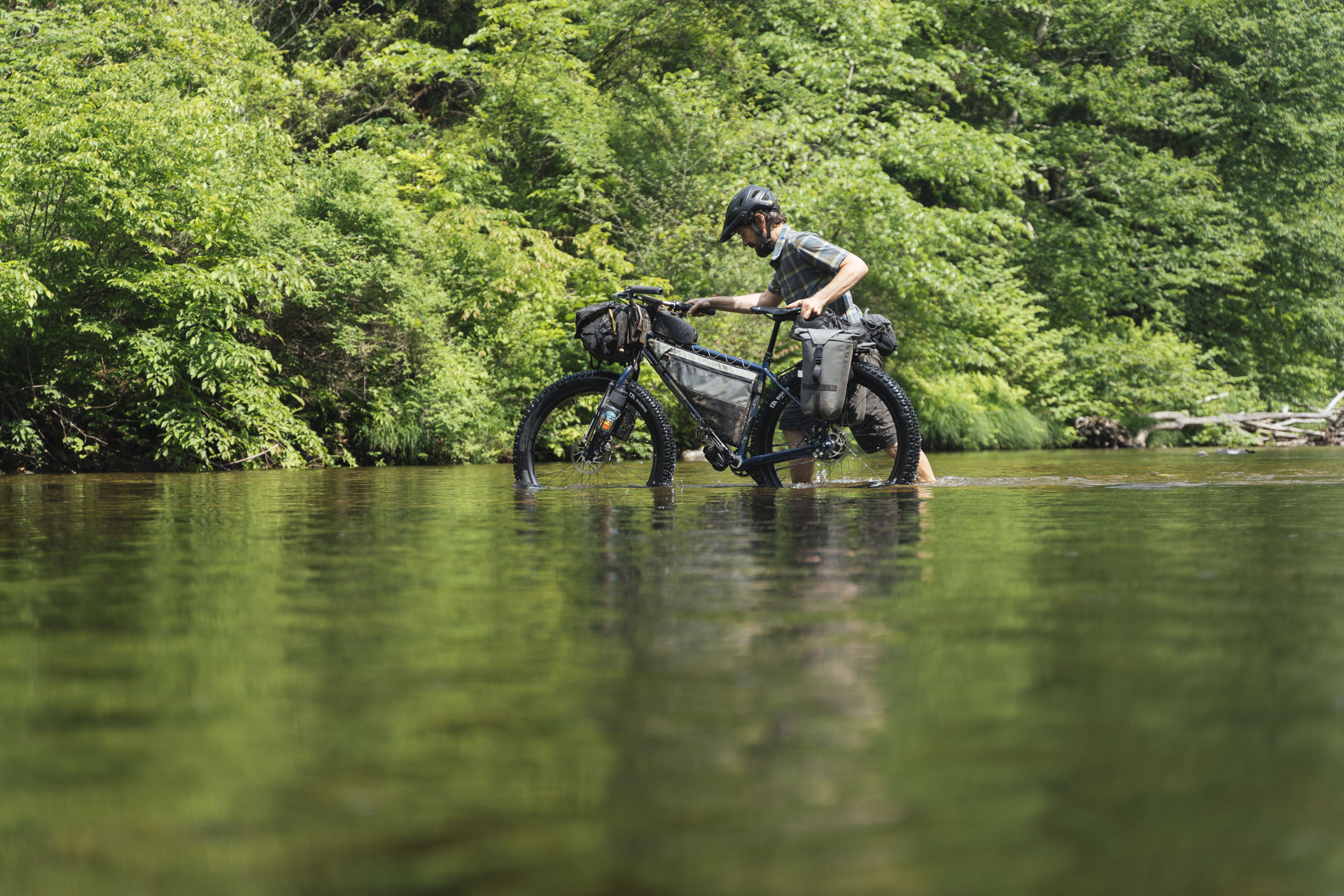
Hints and tip for integrating topographic and geologic maps in your route planning
1. Start by studying the topographic lines on your map.By looking at elevation changes, you can easily assess the normal aspects one would want to know on a route, like whether you will be riding on an uphill or a downhill section, based on your direction of travel. However, also take into consideration the form of the contour lines to consider what the land might look like along that section. Will you be riding in a desert wash or climbing up a ridgeline? How might that affect the availability of shade or water along route? Do you want to plan your route such that you have a long downhill section overlooking a picturesque valley, versus climbing out of that valley and looking more into the uphill section of that same route in reverse?
2. Once you start to establish your route, look also at geologic maps. All geologic maps have a legend that keys the colors on the map to specific rock types. The patterns on the map will give you a sense as to whether or not you will be encountering a region with varying geologic units versus one characterized by the same rock type throughout. Since rocks have varying resistance to weathering and erosion, heterogeneous regions of geologic maps can be places that are also visually stunning or interesting en route.
3. As you fine tune your route, consider your direction of travel. Since rock layers make up the solid portion of the earth and weathering and erosion strips back those rocks to create the variations of the earth surface, as you plan your route, consider how your direction of travel will affect the way you experience that topography and the way in which it will expose different geologic units. The same loop can be very dramatic in one direction as opposed to the other, such as approaching a folded sequence of rock layers that plunge dramatically into the earth (for instance, creating stunning visuals like the San Rafael Reef, pictured) versus riding away from that same location with it at your back for a significant portion of the ride.

4. Finally, take into consideration the type of surface on which you will be riding and how that may impact your travel. While this will be highly variable based on local climate, it’s worth knowing whether or not that layer of shale or mudstone that you’re hoping to traverse for the next 20 miles will become a muddy, clay-laden hellscape after the first bits of rain or whether those beautiful sandstone cliffs you want to go ride beneath might host miles of thick sand in the surrounding desert washes and arroyos. While you can never know all of these factors ahead of time, a little bit of research can help in preparing for a more successful and enjoyable ride. Plus, it can educate you about the area you’ll be riding through!
Judging by the routes you’ve shared on the site, the San Rafael Swell in Central Utah holds a special place in your heart. Tell us more about your motivation behind creating these rides and about collaborating with others to balance riding, history, geology, and an Indigenous perspective of the land.
My first contribution was an overnight route that I co-authored with Patrick Hendry in Central Utah that we coined “A (San Rafael) Swell Night Out”. Both Patrick and I are passionate about getting people to experience the outdoors and lowering the barriers of entry to bikepacking, including the intimidation of what seems like complicated logistics and a fear of getting too remote or out of one’s depth before amassing the experience that comes with time in the backcountry. A goal in establishing this route was therefore to provide accessible riding that was logistically simple without skimping on the surrounding beauty or the immersion that you’d hope for in a bikepacking trip. The San Rafael Swell of Central Utah (a short drive from the riding hotspots of Moab and Fruita) was a perfect location for it in that access is quite straightforward and the geology of the region—an uplifted geologic dome—is breathtaking throughout, providing endless views and the feel of a challenging, remote bikepacking experience.
Following publication, some changes in land use and new Wilderness designations in the San Rafael Swell required a reroute, which resulted in a revised version of the overnighter and the creation of a new 200-mile, multi-day route, The Stone House Lands Loop, in collaboration with Patrick Hendry as well as Neil and Lindsay Beltchenko. Ultimately, these land use changes afforded a fresh opportunity to rethink how riders could experience the immense beauty, stunning geology, and history that the San Rafael Swell has to offer. Since our first route writeup had focused more on the geologic and recent mining history of the area through which it passed, I wanted to be sure the larger Stone House Lands Loop provided a space for an Indigenous perspective of the lands. It was very rewarding to work with Terry Morgart, Cultural Preservation Officer of the Hopi Tribe (descendants of the Fremont People), and a number of other individuals including William Brant (archaeologist at the BLM Price Field Office) and Tiffani Baker (lead museum specialist at the Museum of the San Rafael), who helped give context and voice the rich cultural history of the region.
I truly believe that getting more people on bikes and into the outdoors is one of the best things we can do for our society and our planet. Anything I can do as a route contributor to help others explore a new region by bike, while also providing a fun and rewarding experience, is hugely motivating to me.
One of the aspects that makes the bikepacking community so rich is all its unique rider perspectives. I find that routes where there is a focus or intentionality to the design—be it historical, cultural, food-based, or the geology of a region—are the ones that appeal the most to me and inspire me to ride. In this vein, my wife and I headed back to the San Rafael Swell in the summer of 2023 in search of an entirely different way to experience the region, by slowing things down on our fat bikes and exploring its sandier and less accessible northern sections. The result was last year’s fatpacking route, The Secret Mesa Loop, which ranks among the best riding I have done to date. The San Rafael is truly a special place that I can’t help but return to frequently!
Useful resources
A good place to start your geological journey is to search Google for terms like “interactive geological map of

Onto that stunning bike of yours. From spending time with you, I can see you enjoy putting every part of your bike together yourself, from the wheels up, and have gathered an enviable collection of gravel, trail, commuting, and bikepacking steeds. But let’s hone in on the Tumbleweed Prospector. What encouraged you to choose this particular bike and build it up the way you have?
Building up bikes, my own and for others, has become a passion project over the last few years. It has also allowed me to test out a bunch of bikes while also helping get friends on bikes in the process. Our own bike stable is constantly in flux, but I’ve long been a stalwart supporter of plus and fatbikes since they offer such a versatile platform for bikepacking and serve a variety of riding needs so darn well. I was an early adopter of the Surly Krampus, and that bike served as my one-bike solution for quite some time. However, as I got more and more into bikepacking, I found myself constantly rebuilding it and swapping it between a more trail-oriented geometry (flat bars and singlespeed) for daily rides and a more purpose-built bikepacking setup (dynamo and Jones bars) for longer days in the saddle. As trips became more frequent, it got to be cumbersome. When I was able to get my hands on a Surly ECR frameset, it took over most of the bikepacking-specific roles in my stable, as I found its geometry lended itself a bit more readily to longer days in the saddle.
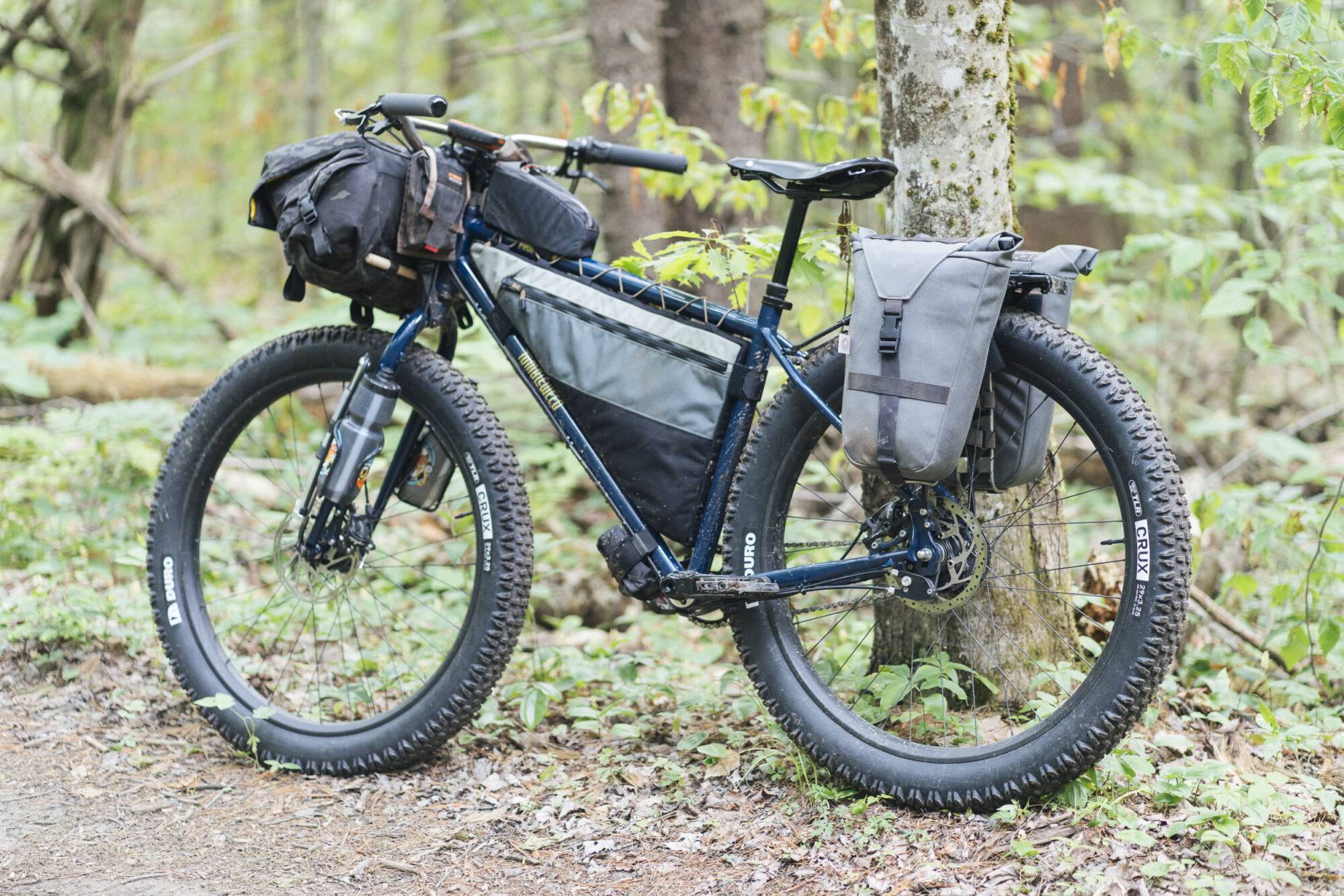
Fast-forwarding a few years, with N+1 calculating on recursion, I ended up having a Surly ECR (bikepacking rig), Surly Krampus (singlespeed hardtail), Surly Karate Monkey (suspension fork trail hardtail) and a Surly Ice Cream Truck (winter fatbiking) in the stable! Things were starting to feel a bit redundant and overwhelming. Somewhere around that time, I saw the first images on the site of the Tumbleweed Prospector from your Mongolia trip, and a lightbulb went off in my head. I had already considered getting a Rohloff for my ECR, so when the production version of the Prospector came out—with its ability to run plus or four-inch fat tires with a standard mountain bike crankset, a Rohloff hub, suspension fork, and dropper post—it was a no brainer. After spending the next year or so selling off most of my stable, I was able to build up a Prospector with two wheelsets (29+ and Fat), which took over the duties of all four of those bikes combined.
That’s a lot of preamble to explain what should be pretty obvious: the Tumbleweed Prospector is a very impressive design feat and a truly exceptional bike, from the Rohloff-focused dropouts and its custom yoke to its multiple provisions for rack and bag mounts. I can think of few others that deliver so well on their intent and promise, and so effortlessly and with such little compromise. Put simply, Tumbleweed owner Daniel Malloy has created something quite special.
As an expedition bikepacking bike, the Prospector is the one you want when you don’t want to worry about gear. For this reason, it has been my go-to for most of my trips. Over the years, I’ve built it up in pretty much all of the possible configurations, but my favorite has to be its current form: fully rigid (swapping between 29+ or fat wheels depending on the intended riding terrain) with swoopy custom titanium handlebars and a OneUp dropper post. My time-tested combination of bags includes a Bags By Bird Goldback up front, stem and top tube bags by Bedrock Bags and Randi Jo Fab, and my custom framebag and nano panniers, featuring the immaculate work of Andrew the Maker.
Speaking of handlebars, I think we need to know more about that titanium beauty. Harking back to the likes of a Nitto Albatross bar, the bars are so elegant and you looked so comfortable!
I could talk at length about these custom Black Sheep Bikes Ti Mountain Mustache Bars! James at Black Sheep in Colorado was awesome to deal with and built up an absolute stunner exactly to my specs. They’re 800mm wide and have 60mm of rise, a 12 degree bend up front, and a 57 degree bend in the main control section of the bar with added length to accommodate my Rohloff shifter. I also required the flat section at the clamp to be a bit wider than his standard Mountain Moustache bars to allow for the attachment of various bikepacking bags—specifically my Bags By Bird Goldback mentioned above.
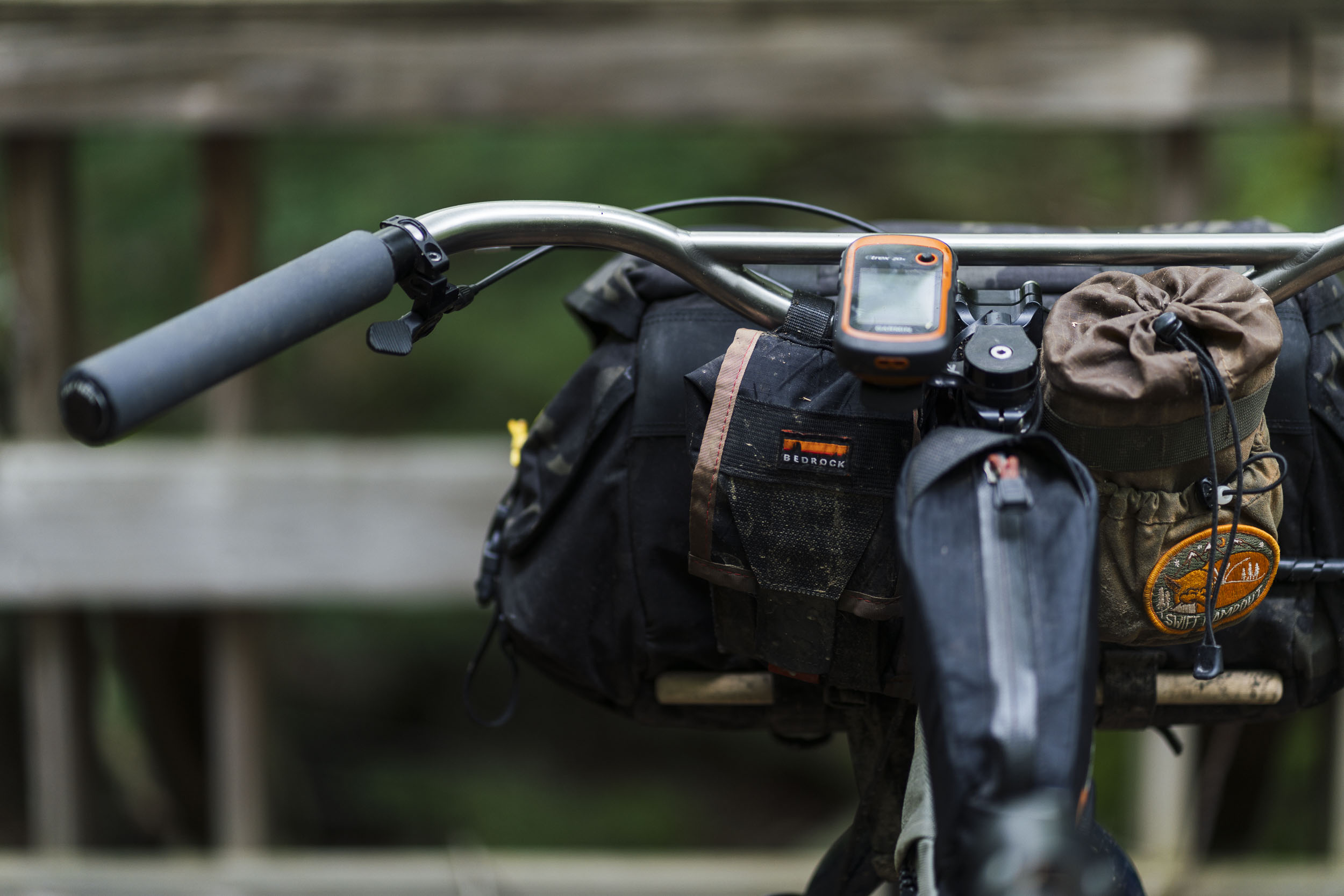
When I was mocking up the angles to this bar and working with James, my only concern was that while I wanted that more extreme bend of 57 degrees in the flats, I was worried that it may end up feeling like the steering would be too slow or that I could pin myself in between the bars on more technical terrain—something that happened to me with Jones 710 bars in the past, resulting in one of my worst crashes to date and a serious leg injury at the time. Luckily, the opposite is true of these bars. At 800mm wide, the steering is fast and precise and the cockpit is extremely roomy. There is ample space to move my hands around forward and back for varied hand positions. Not only do these bars check off all of my criteria, but they also look incredible and are supremely comfortable. The damping of titanium is real! Put succinctly, they’re awesome and nothing short of perfection!
Do you have any travel plans coming up? Any published routes you’d like to ride or countries you’d like to visit?
The list of places is endless! How much space do we have left in this write-up?! All of the those that sit atop my list are geologically or culturally interesting in one way or another, since I can’t help but find varied landscapes as much of a draw when traveling as I do meeting new people and having new experiences. For that reason, the published routes in Iceland are exerting a massive pull, and I hope we will be able to hit up at least one in 2024. My wife and I also want to make a return to Greece, a country I’ve been fortunate enough to work in a great deal over the years but never have been able to enjoy by bike. And of course, it goes without saying, we need to make it down to Oaxaca!
Prospector Highlights
- Frame: Tumbleweed Prospector (Gen 3, Size Large)
- Fork: Tumbleweed steel 135mm quick release
- Headset: Cane Creek 40
- Stem: Paul Components Boxcar 70mm
- Handlebar: Black Sheep Bikes custom Mountain Mustache titanium
- Grips: ESI Extra Chunky Grips
- Brakes: TRP Spyke Mechanical with Paul Components Love Levers
- Rotors: Sram Centerline 200 (front) / 180 (rear)
- Shifter: Rohloff twist shifter
- Cranks: Raceface Turbine 170mm
- Chainring: 32t steel flipped for 58mm Rohloff Chainline
- Cassette: None
- Chain: Sram PC-901
- Front hub: Son 28 dynamo 135mm, 6-bolt disc
- Rear hub: Rohloff Speedhub 500/14 135mm disc, bolt on
- Spokes: Sapim Race
- Rims: Light Bicycle Recon RM29C15 carbon i45
- Tires: Duro Crux 29 x 3.25
- Seatpost: OneUp Components v2 dropper post, 150mm travel
- Saddle: Selle Anatomica X1
- Pedals: OneUp Components Composite Pedals
Other notes: Sinewave Cycles Reactor wired to SON dynamo hub for USB charging of electronics, Swood Cycles Twisted T bar front bag support, Tumbleweed T-rack with King Cages for rear cargo.
Further Reading
Make sure to dig into these related articles for more info...
Please keep the conversation civil, constructive, and inclusive, or your comment will be removed.













